#this is a marked contrast to anne in the first season
Explore tagged Tumblr posts
Text
Sasha's Eyes - Visual storytelling
So, I once saw someone question why it's Sasha(The European descadant) who has small, slanted eyes, while Anne and Marcy both have huge, cartoony eyes.
I didn't really take the overall question too seriously, as Amphibia's simplistic artstyle does not lend itself well to show subtler ethnic differences beyond skin color, but it did make me question, from a real life perspective, why DOES Sasha have such small eyes?

The answer is contrast. The contrast between her eyes and her pupils to be exact.
Amphibia as a whole uses pupil size as an indicator of a characters mood, with the eyes going wider to signal a shift into more emotional territory.

The thing about Sasha though, is that because her eyes are so much smaller than Anne's and Marcy's, this contrast when her pupils widen is much, much more noticable.
In Prison Break, Sasha's pupils are generally small, to signify that she doesn't truly care about the tower(Not yet anyway), meanwhile, all throughout Reunion, Sasha's pupils are bigger, showcasing that Anne, is the thing she cares about more than anything else.

And then, near the climax, her pupils shrink drastically, signifying that Sasha is embracing all her darker impulses.

And these don't really go away for a while either. Outside of a few select moments, Sasha keeps her smaller pupils through season 2, until she finally reunites with Anne and Marcy.

It's quite the contrast, and goes to show how much Sasha actually wants this. THIS is what she actually wants. Not to rule. Not to dominate. Just to have Anne's and Marcy's love. This is where Sasha's heart truly is.

It's a very nice, subtle bit of visual storytelling.
But then, as the old relationship begins falling into place, Sasha falls right back into her old, toxic habits, and her eyes change accordingly.

Right back to how they've been for the majority of the season, showcasing that Sasha still hasn't grown, still hasn't managed to leave her toxicity in the past, nor has she made an effort to do so.

It's only at the end, where Sasha finally, truly embraces the love she has for her besties, and comes through for them, that Sasha's eyes go back to being large, showcasing her caring side.
In this pattern, True Colors is kinda an outlier, as the Rollercoaster of emotions and turns the episode has, also means that Sasha's eyes are all over the place.

However, Turning Point, marks a... Well a decisive turning point in regards to Sasha's design, as in this episode, the small, dotty pupils are practically completely gone.
Replaced by Sasha's big, pupils, showcasing her caring as now dominant.

And this continues into Commander Anne.
Sasha's eyes have completely lost her smaller pupils, creating a much, much stronger contrast where her smaller eyes are filled much, much more by her pupils, signifying her growth.
Unlike the last time Sasha reunited with Anne, this time she genuinely has changed. She is playing for keeps this time, as her heart, mind and souls are all now united and honest with herself for the first time.
280 notes
·
View notes
Text
Chicago at Long Beach, LA, 1992: A Story of Bebe Neuwirth, Choreography, Riots, Revivals, and Relevance
Recently and rather excitingly, more footage made its way to YouTube of the 1992 version of Chicago staged at Long Beach in LA, featuring Bebe Neuwirth as Velma and Juliet Prowse as Roxie.
Given its increased accessibility and visibility, this foregrounds the chance to talk about the show, explore some of its details, and look at the part it might have played as a contribution to the main ‘revival’ of Chicago in 1996 – which has given the show one of the most resonant and highly enduring legacies seen within the theatre ever.

This Civic Light Opera production at Long Beach was staged in 1992, four years before the ‘main’ revival made its appearance at Encores! or had its subsequent Broadway transfer, and it marked the first time a major revival of Chicago had been seen since the original 1975 show disappeared nearly 15 years previously.
This event is of particular significance given its position as the first step in the chain of events that make up part of this ‘new Chicago’ narrative and the resultant entire multiple-decade spanning impact of the show hereafter.
But for all of its pivotal status, it’s seldom discussed or remembered anywhere near as much as it should be.
This may be in part because of how little video or photographic record has remained in easily accessible form to date, and also because it only played for around two weeks in the first place. As such, it is a real treat on these occasions to get to see such incredible and unique material that would otherwise have been lost forever after such a brief existence some 30 years ago.
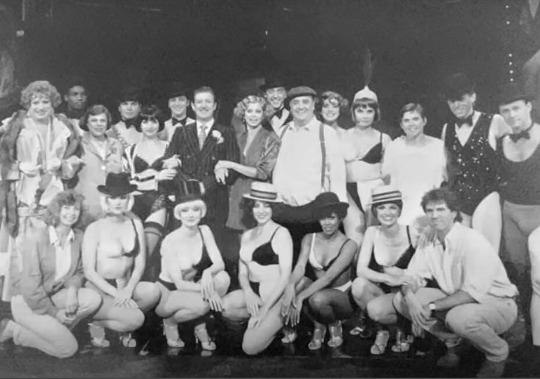
This earlier revival of the show still feels like what we have come to identify “Chicago” as in modern comprehension of the musical, most principally because the choreography was also done by Ann Reinking. As with the 1996 production, this meant dance was done “very much in the master’s style” – or Mr Bob Fosse.
The link below is time-stamped to Bebe and Juliet performing ‘Hot Honey Rag’. As one of the most infamous numbers in Broadway history, it’s undoubtedly a dance that has been watched many times over. But never before have I seen it done quite like this.
https://youtu.be/4HKkwtRE-II?t=2647
‘Hot Honey Rag’ was in fact formerly called ‘Keep It Hot’, and was devised by Fosse as “a compendium of all the steps he learned as a young man working in vaudeville and burlesque—the Shim Sham, the Black Bottom, the Joe Frisco, ‘snake hips,’ and cooch dancing”, making it into the “ultimate vaudeville dance act” for the ultimate finale number.
Ann would say about her choreographical style in relation to Fosse, “The parts where I really deviate is in adding this fugue quality to the numbers. For better or worse, my style is more complicated.” The ‘complexity’ and distinctness she speaks of is certainly evident in some of the sections of this particular dance. There are seemingly about double the periodicity of taps in Bebe and Juliet’s Susie Q sequence alone. One simply has to watch in marvel not just at the impressive synchronicity and in-tandem forward motion, but now also at the impossibly fast feet. Other portions that notably differ from more familiar versions of the dance and thus catch the eye are the big-to-small motion contrast after the rising ‘snake hips’ section, and all of the successive goofy but impeccably precise snapshot sequence of arm movements and poses.
More focus is required on the differences and similarities of this 1992 production compared against the original or subsequent revival, given its status and importance as a bridging link between the two.
The costumes in 1975 were designed by Patricia Zipprodt (as referenced in my previous post on costume design), notably earning her a Tony Award nomination. In this 1992 production, some costumes were “duplications” of Zipprodt’s originals, and some new designs by Garland Riddle – who added a “saucy/sassy array” in the “typical Fosse dance lingerie” style. It is here we begin to see some of the more dark, slinkiness that has become so synonymous with “Chicago” as a concept in public perception.
The sets from the original were designed by Tony Walton – again, nominated for a Tony – and were reused with completeness here. This is important as it shows some of the original dance concepts in their original contexts, given that portions of the initial choreography were “inextricably linked to the original set designs.” This sentiment is evident in the final portion of ‘Cell Block Tango’, pictured and linked at the following time-stamp below, which employs the use of mobile frame-like, ladder structures as a scaffold for surrounding movements, and also a metaphor for the presence of jail cell bars.
https://youtu.be/4HKkwtRE-II?t=741
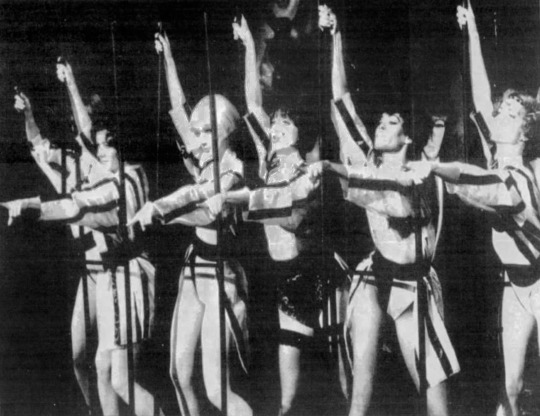
Defining exactly how much of the initial choreography was carried across is an ephemeral line. Numbers were deemed “virtually intact” in the main review published during the show’s run from the LA Times – or even further, “clones” of the originals. It is thought that the majority of numbers here exhibit greater similarity to the 1975 production than the 1996 revival, except for ‘Hot Honey Rag’ which is regarded as reasonably re-choreographed. But even so, comparing against remaining visible footage of Gwen Verdon and Chita Rivera from the original, or indeed alternatively against Bebe and Annie later in the revival, does not present an exact match to either.
This speaks to the adaptability and amorphousness of Fosse-dance within its broader lexicon. Fosse steps are part of a language that can be spoken with subtle variations in dialect. Even the same steps can appear slightly different when being used in differing contexts, by differing performers, in differing time periods.
It also speaks to some of the main conventions of musical theatre itself. Two main principles of the genre include its capacity for fluidity and its ability for the ‘same material’ to change and evolve over time; as well as the fact comparisons and comprehensions of shows across more permanent time spans are restricted by the availability of digital recordings of matter that is primarily intended to be singular and live.
Which versions of the same song do you want to look at when seeking comparisons?
Are you considering ‘Hot Honey Rag’ at a performance on the large stage at Radio City Music Hall at the Tony Awards in 1997? Or on a small stage for TV shows, like the Howard Cosell or Mike Douglas shows in 1975? Or on press reel footage from 1996 on the ‘normal’ stage context in a format that should be as close to a replica as possible of what was performed in person every night?
Bebe often remarks on and marvels at Ann’s capacity to travel across a stage. “If you want to know how to travel, follow Annie,” she says. This exhibits how one feature of a performance can be so salient and notable on its own, and yet so precariously dependent on the external features its constrained to – like scale.
Thus context can have a significant impact on how numbers are ultimately performed for these taped recordings and their subsequent impact on memory. Choreography must adjust accordingly – while still remaining within the same framework of the intention for the primary live performances.
This links to Ann’s own choreographical aptitude, in the amount of times it is referenced how she subtly adapted each new version of Chicago to tailor to individual performers’ specific merits and strengths as dancers.
Ann’s impact in shaping the indefinable definability of how Chicago is viewed, loved and remembered now is not to be understated.
An extensive 1998 profile – entitled “Chicago: Ann Reinking’s musical” – explores in part some of Ann’s approaches to creating and interacting with the material across a long time span more comprehensively. Speaking specifically to how she choreographed this 1992 production in isolation, Ann would say, “I knew that Bob’s point of view had to permeate the show, you couldn’t do it without honoring his style.” In an age without digital history at one’s fingertips, “I couldn’t remember the whole show. So I choreographed off the cuff and did my own thing. So you could say it was my take on his thoughts.” Using the same Fosse vocabulary, then – “it’s different. But it’s not different.”
One further facet that was directly carried across from the initial production were original cast members, like Barney Martin as returning as Amos, and Michael O'Haughey reprising his performance as Mary Sunshine. Kaye Ballard as Mama Morton and Gary Sandy as Billy Flynn joined Bebe and Juliet to make up the six principals in this new iteration of the show.
Bebe, Gary and Juliet can be seen below in a staged photo for the production at the theatre.

The venue responsible for staging this Civic Light Opera production was the Terrace Theatre in Long Beach in Los Angeles. Now defunct, this theatre and group in its 47 years of operation was credited as providing some of “the area’s most high profile classics”. Indeed, in roughly its final 10 years alone, it staged shows such as Hello Dolly!, Carousel, Wonderful Town (with Donna McKechnie), Gypsy, Sunday in the Park with George, La Cage aux Folles, Follies, 1776, Funny Girl, Bye Bye Birdie, Pal Joey, and Company. The production of Pal Joey saw a return appearance from Elaine Stritch, reprising her earlier performance as Melba Snyder with the memorable song ‘Zip’. This she had done notably some 40 years earlier in the original 1952 Broadway revival, while infamously and simultaneously signed as Ethel Merman’s understudy in Call Me Madam as she documented in Elaine Stritch at Liberty.
Juliet Prowse appeared as Phyllis in Follies in 1990, and Ann Reinking acted alongside Tommy Tune in Bye Bye Birdie in 1991, in successive preceding seasons before this Chicago was staged.
But for all of its commendable history, the theatre went out of business in 1996 just 4 years after this, citing bankruptcy. Competition provided in the local area by Andrew Lloyd Webber and his influx of staging’s of his British musicals was referenced as a contributing factor to the theatre group’s demise. This feat I suspect Bebe would have lamented or expressed remorse for, given some of her comments in previous years on Sir Lloyd Webber and the infiltration of shows from across the pond: “I had lost faith in Broadway because of what I call the scourge of the British musicals. They've dehumanized the stage [and] distanced the audience from the performers. I think 'Cats' is like Patient Zero of this dehumanization.”
That I recently learned that Cats itself can be rationalised in part as simply A Chorus Line with ears and tails I fear would not improve this assessment. In the late ‘70s when Mr Webber noticed an increase of dance ability across the general standard of British theatre performers, after elevated training and competition in response to A Chorus Line transferring to the West End, he wanted to find a way he could use this to an advantage in a format that was reliable to work. Thus another similarly individual, sequential and concept-not-plot driven dance musical was born. Albeit with slightly more drastic lycra leotards and makeup.
But back in America, the Terrace theatre could not be saved by even the higher incidence of stars and bigger Broadway names it was seeing in its final years, with these aforementioned examples such as Bebe, Annie, Tommy, Juliet, Donna, or Elaine. The possibility of these appearances in the first place were in part attributable to the man newly in charge as the company’s producer and artistic director – Barry Brown, Tony award-winning Broadway producer.
Barry is linked to Bebe’s own involvement with this production of Chicago, through his relationship – in her words – as “a friend of mine”.
At the time, Bebe was in LA filming Cheers, when she called Barry from her dressing room. Having been working in TV for a number of years, she would cite her keenness to find a return to the theatre, “[wanting] to be on a stage so badly” again. The theatre is the place she has long felt the most sense of ease in and belonging for, frequently referring to herself jokingly as a “theatre-rat” or remarking that it is by far the stage that is the “medium in which I am most comfortable, most at home, and I think I'm the best at.”
Wanting to be back in that world so intensely, she initially proposed the notion of just coming along to the production to learn the parts and be an understudy. Her desire to simply learn the choreography alone was so strong she would say, “You don’t have to pay me or anything!”
She’d had the impetus to make the call to Barry in the first place only after visiting Chita Rivera at her show in LA with a friend, David Gibson. At the time, the two did not know each other that well. Bebe had by this point not even had the direct interaction of taking over in succession for Chita in Kiss of the Spider Woman in London. This she would do the following year, with Chita guiding her generously through the intricacies of the Shaftesbury Theatre and the small, but invaluable, details known only to Chita that would be essential help in meeting stage cues and playing Aurora.
Bebe had already, however, stepped into Chita’s shoes multiple times, as Anita in West Side Story as part of a European tour in the late ‘70s, or again in a Cleveland Opera Production in 1988; and additionally as Nickie in the 1986 Broadway revival of Sweet Charity – both of which were roles Chita had originated on stage or screen. In total, Velma would bring the tally of roles that Bebe and Chita have shared through the years to four, amongst many years also of shared performance memories and friendship.
They may not have had a long history of personal rather than situational connections yet when Bebe visited her backstage at the end of 1991, but Chita still managed to play a notable part in the start of the first of Bebe’s many engagements with Chicago.
After Bebe hesitantly relayed her idea, Chita told her, “You should call! Just call!”
So call Bebe did. One should listen to Chita Rivera, after all.
Barry Brown rang her back 10 minutes later after suggesting the idea to Ann Reinking, who was otherwise intended to be playing Velma. The response was affirmative. “Oh let her play the part!”, Annie had exclaimed. And so begun Bebe’s, rather long and very important, journey with Chicago.
In 1992, this first step along the road to the ‘new Chicago’ was well received.
Ann Reinking with her choreography was making her first return to the Fosse universe since her turn in the 1986 Sweet Charity revival. Diametrically, Rob Marshall was staring his first association with Fosse material in providing the show’s direction – many years before he would go on to direct the subsequent film adaptation also. Together, they created a “lively, snappy, smarmy” show that garnered more attention than had been seen since the original closed.
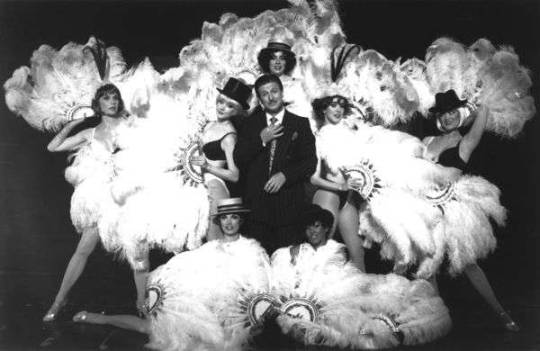
“Bob Fosse would love [this production],” it was commended at the time, “Especially the song-and-dance performance of Bebe Neuwirth who knocks everyone’s socks off.” High praise.
Bebe was also singled out for her “unending energy”, but Juliet too received praise in being “sultry and funny”. Together, the pair were called “separate but equal knockouts�� and an “excellent combination”.
Juliet was 56 at the time, and sadly died just four years later. Just one year after the production though, Juliet was recorded as saying, “In fact, we’re thinking of doing it next year and taking it out on the road.”
Evidently that plan never materialised. But it is interesting to note the varied and many comments that were made as to the possibility of the show having a further life.
Bebe at the time had no recollection that the show might be taken further, saying “I didn’t know anything about that.” Ann Reinking years later would remark “no one seemed to think that the time was necessarily ripe for a full-blown Broadway revival.” While the aforementioned LA Times review stated in 1992 there were “unfortunately, no current plans” for movement, it also expressed desire and a call to action for such an event. “Someone out there with taste, money and shrewdness should grab it.”
The expression that a show SHOULD move to Broadway is by no means an indication that a show WILL move. But this review clearly was of enough significance for it to be remembered and referenced by name by someone who was there when it came out at the time, Caitlin Carter, nearly 30 years later. Caitlin was one of the six Merry Murderesses, principally playing Mona (or Lipschitz), at each of this run, Encores!, and on Broadway. She recalled, “Within two days, we got this rave review from the LA Times, saying ‘You need to take the show to Broadway now!’” The press and surrounding discussions clearly created an environment in which “there was a lot of good buzz”, enough for her to reason, “I feel like it planted seeds… People started to think ‘Oh we need to revive this show!’”
The seeds might have taken a few years to germinate, but they did indeed produce some very successful and beautiful flowers when they ultimately did.
In contrast with one of the main talking points of the ‘new Chicago’ being its long performance span, one of the first things I mentioned about this 1992 iteration was the rather short length of its run. It is stated that previews started on April 30th, for an opening on May 2nd, with the show disappearing in its final performance on May 17th. Less than a fleeting 3 weeks in total.
Caitlin Carter discussed the 1992 opening on Stars in the House recently. It’s a topic of note given that their opening night was pushed back from the intended date by two days, meaning Ann Reinking and Rob Marshall had already left and never even saw the production. “The night we were supposed to open in Long Beach was the Rodney King riots.”
Local newspapers at the time when covering the show referenced this large and significant event, by noting the additional two performances added in compensation “because of recent interruptions in area social life.”
It sounds rather quaint put like that. In comparison, the horror and violence of what was actually going on can be statistically summated as ultimately leaving 63 people dead, over 2300 injured, and more than 12,000 having been arrested, in light of the aftermath of the treatment faced by Rodney King. Or more explicitly, the use of excessive violence against a black man at police hands with videotaped footage.
A slightly later published review wrote of how this staging was thus “timely” – in reference to an observed state of “the nation’s moral collapse”.
‘Timeliness’ is a matter often referenced when discussing why the 1996 revival too was of such success. The connection is frequently made as to how this time, the revival resonated with public sentiment so strongly – far more than in 1975 when the original appeared – in part because of the “exploding headlines surrounding the OJ Simpson murder case”. The resulting legal and public furore around this trial directly correlates with the backbone and heart of the musical itself.
I'm writing this piece now at the time of the ongoing trial to determine the verdict of George Floyd’s murder, another black man suffering excessive and ultimately fatal violence at police hands with videotaped footage.
I think the point is that this is never untimely. And that the nation is seldom not in some form of ‘moral collapse’, or facing events that have ramifications to do with the legal system and are emotionally incendiary on a highly public level.
Which perhaps is why Chicago worked so well not just in 1996, but also right up to the present day.
Undoubtedly, we live in a climate where the impact of events is determined not just by the events themselves, but also the manner in which they are reported in the media. Events involving some turmoil and public outrage at the state and outcome of the legal system are not getting any fewer or further between. But the emphasis on the media in an increasingly and unceasingly digital age is certainty only growing.
#chicago#chicago the musical#chicago musical#bebe neuwirth#juliet prowse#ann reinking#bob fosse#fosse#dance#broadway#musicals#theatre#theatre history#choreography#gwen verdon#chita rivera#long reads#writing#george floyd#rodney king#oj simpson#dancing#dancer#andrew lloyd webber#cats the musical#musical theatre
78 notes
·
View notes
Text
His Hufflepuff Secret~ Three

<-Previous Chapter
_____
Year IV
Draco sees her sitting under an old oak tree. The slight winter breeze blowing her hair in her face while she reads. He stands near the bottom of the hill as he admires her. Delicate fingers turning the page of the tattered muggle book, her big Y/E/C eyes going over the words, lips slightly turning into a smile as she transports herself into the story. Draco can stare at the sight all day. In fact, he wants to, but there is an important matter that needs to be discussed, so he shakes his head and continues up the hill.
"Hey there, beautiful," Draco pops up from behind the tree, making Y/N jump and drop her book.
"Dammit Draco, you made me lose my page!" Y/N whines at him. She picks up her book and dusts off the twigs and snow, silently thanking whomever was listening that the book has a hard cover.
Draco just grins at her, "Haven't you read that silly little book, oh I don't know, a million times already? Surely you'll remember exactly where you left off."
She glares up at him, "It's not just a 'silly little book'. It just so happens to be a classic in the muggle world."
"You know, you're cute when you're mad," he crouches down so that his face is level with hers, "That's why I love winding you up."
Y/N mocks offence, "I'm cute only when I'm mad?" she puts the back of her hand on her forehead and tilts her head up and to the side, "And here I thought that I look cute all the time."
"Nah, darling," Draco takes her hand in his and kisses it, not breaking eye contact, "The rest of the time, you just look incredibly gorgeous."
She smiles at his antics. Their friendship mostly consists of a lot of teasing and flirting, so she's used to physical contact with him. They only ever go as far as a kiss on the cheek, much to her dismay. Somewhere in the two years they've been friends, Y/N developed feelings for the Slytherin. Their secret meetings by the lake before breakfast, their afternoon 'studying lessons' in the library, and the astronomy tower hangouts after dark, where they just talk about their day and watch the stars in the sky. She thinks of the way that one knowing look from him in class can make her feel better. Even little things like his hand not so accidentally brushing against hers as they pass each other in the hallways make her heart flutter and her feelings for him grow even more. She's so lost in thought that she didn't notice that Draco has moved to sit down beside her, still not letting go of her hand.
Draco just watches her, knowing she is thinking about something because of the way she is chewing at the corner of her lip. She seems to snap out of her trance when she catches him staring. "What?"
"C-can I ask you something?" Come on, Draco, pull yourself together. Whatever she says, it's not going to be the end of the world, he tries to assure himself. Ever since Draco had that nightmare last year, he's been a bit more protective over Y/N. He's always checking up on her and being with her when no one is around. He has grown to love their friendship but Draco also started to fall in love with her; the girl of his dreams. That's why he is so excited for the ball coming up. He gets a night to finally show her how he truly feels about her, and hopefully, she returns his affections.
Y/N raises her eyebrows and turns her head to look at him. Draco never stutters unless he's scared, nervous or about to break down, so she squeezes his hand to let him know that he's alright. "Sure, ask away." She notices that he seems different from when he startled her earlier. The cocky and playful expression on his face now replaced with uncertainty and nerves.
He takes a deep breath, it's now or never, Draco, "W-wouldyouliketogototheYuleballwithme?" Draco manages to mumble out.
"W-what?" It's her turn to stutter now, not actually believing her ears.
"I said," Draco's face becomes a bit more serious after he clears his throat, his voice more confident than before, "Would you be my date for the Yule Ball?"
Y/N's mouth drops. Is this actually happening? Did Draco Malfoy, my best friend, really just ask me out? "What about the other students? Won't they be talking about us when we show up at the ball together?" She avoids asking him if this date meant a date date, or just two friends going to a dance together... as friends.
"Who cares if they talk about us?" Draco defends, "I'm tired of hiding the fact that I'm friends with such an amazing girl like you. And besides," he lets go of her hand and moves his up to her face, rubbing his thumb in slow circles on her cheek, "All the boy's will be jealous that I've got the most beautiful girl on my arm." His signature smirk now making its way on his lips.
She instinctively melts into his touch and closes her eyes. His hand feels warm, a sharp contrast to the cold of the season. She has been out under the tree for a while now, getting lost once again in the world of Anne Frank, when Draco showed up. Y/N sighs, "Okay," she nods, slowly. Opening her eyes again, she sees that Draco has a huge smile on his face. She can't help but smile with him. Even though he said 'friends', she's still happy to being going to the ball with him. "Just as friends?" she whispers, without meaning to actually say it out loud.
Draco seems surprised at the question but quickly covers up his shock. He smiles once again and moves his face closer to her until his lips brushes hers, ever so lightly, their breaths mingling. "Hey sweetheart?"
"Yeah?"
"You're shaking."
Y/N pulls away and looks down at her hands. They really are shaking. "Oh."
"Come on, let's get you inside," Draco stands and takes the book from her so that she can put her hands in her pockets. They make their way back to the school. The tree is quite a long ways away because it's where the two hang out, away from other students. The journey is silent. Neither of them know what to say.
The air surrounding them has changed. There is tension that wasn't there before and they both know it. Whatever it was that happened, or rather almost happened, by the tree made it so. Inside their minds, they are both cursing themselves for not moving closer.
When they reach the courtyard, Y/N suddenly speaks up, "What should I wear?"
Draco looks at her confused. He then realises that she's asking about the ball, "Anything you wear would look good."
"Well, obviously I know that," she flips her hair back playfully, "But if we're going to go to the ball together, I think it would be nice to match with each other."
"You think too much, you know that?" He jokes, "You may as well be in Ravenclaw for that overworking brain of yours."
"Tell that to my failing Potions mark," she laughs, thinking back to the cauldron she accidentally exploded while brewing a Drowsiness Draught. "Seriously though, what should I wear?"
"A dress in my favourite colour, perhaps?" Draco answers. He has definitely NOT thought of his best friend wearing an emerald green gown and completely taking over the dance floor with her.
"Green would look terrible on me!"
"Y/N Fawley," he wraps an arm around her waist to pull her close, his free hand cups her chin and makes her look up at him, "You would look outrageously perfect in anything and everything." Draco looks deep into her eyes, telling her that he means it.
"Alright," she sighs in defeat. Y/N can't help the butterflies fluttering in her stomach at his words. She feels the blood rushing to her cheeks so she looks down to hide it. If Draco notices, she hopes he'll think she's blushing because of the cold.
"Good," Draco smiles and kisses her cheek. He lets her go then continues to walk to the castle. He turns back right before he goes through the doors. "Will I see you tonight at the tower?" He asks, knowing that she might not be able to come because she's got Hermione helping her with Potions.
"We'll see," she answers, unsure if her Gryffindor friend will let her leave her side until she's caught up with everything they've covered so far in the lessons. Draco nods understandingly and smiles at her. Y/N blows him a kiss before he goes. After the door clicks shut, she takes a deep breath. She brings a finger to her lips as she recalls her almost-kiss with Draco. Had he meant to do that? Will he try to do it again? Will I try to make a move? Her thoughts are filled with questions she's not sure she wants answered. She thinks back to last year, when she saw Cedric and Cho kissing in the common room. Y/N wanted her first kiss to be like that with Draco. She always pictured it, dreamt about it even. Sadly, her first kiss was taken by Dean Thomas, on a Thursday night game of truth or dare with the Gryffindors. Not that she didn't like the kiss. It was soft and gentle, but also awkward and weird, given that it happened in front of everyone. Still, she wishes that it was Draco's lips on hers instead. If it was the blonde haired boy she kissed, she wouldn't care if it happened in front of people.
Y/N lets out a huff, trying to shake off the million thoughts and questions racing in her head. She walks into the school, taking in the warmth of the castle, and heads to the Great Hall for dinner. She spots the Golden Trio at the Gryffindor table, waving her over. They eat and talk, Ron doing most of the talking even though his mouth is stuffed full with fried chicken. Hermione slaps him on the arm, reminding him to not eat like a pig with all the grease and chicken bits falling from his chin. While they're all laughing, Y/N's eyes land on the Slytherin table. Draco seems to be glaring at them, mainly Harry, but once he sees her looking at him, his eyes soften and he gives her a small smile.
~~~~•~~~~
"Hermione no! We've been doing this for ages," Y/N whines at her best friend, slumping further into her chair, "Let's face it, if it's not ingrained into my brain after reading all these books over and over again, then it never will!"
The curly-haired brunette rolls her eyes at her, "I don't know how else to help you, Y/N. Besides, we've made some progress since we started," Hermione looks sympathetically at her defeated friend. "What's the difference between unicorn hair and billywig sting slime?"
"The slime is usually what makes any potion bubble and the unicorn hair makes it change colour," she answers almost immediately. Hermione grins at her and it takes Y/N a second before her eyes widen. "Oh my god!" She moves her hands excitedly.
"You see? You're getting better," Hermione says in an 'I told you so' tone, but looking proud at her friend. "I guess we can stop there for the night. Malfoy must be waiting for you at the tower."
"Mione!" Y/N gives her a warning look, "Speak quieter please," she looks around the Gryffindor common room to see if anyone heard anything. To her relief, a couple of boys were sat across the room from them, out of earshot. Hermione is the only person that knows about her friendship with Draco. They didn't mean for her to find out, but being the genius that she is, she figured out where Y/N slips off to every time she disappears. Both Draco and Y/N were expecting her to freak out about it, but to their surprise, Hermione was quite supportive of their relationship. Saying something about Malfoy needing a good influence like her in his life. Y/N looks at the time on her watch then looks back up at Hermione, "It's late, so he's probably back in his dorm already."
"Oh, okay. Well then you better get back to your dorm, too. You wouldn't want to get caught in the halls after curfew and get detention," Hermione replies.
"Actually, speaking of Malfoy," Y/N starts, "He's asked me to go to the Yule Ball with him."
Hermione's jaw drops, "Did he really?", she squeals, making the boys in the room turn their heads in their direction for a second. Both Hermione and Y/N mutter a 'sorry' before continuing their conversation.
"Yes, he really did," Y/N whispers in reply.
"But just as friends, right?" Hermione questions, "I mean, he can't possibly want people thinking you two are dating. No offence."
"None taken," Y/N replies, "But that's the thing! He said he doesn't care if people find out we're friends, and when I asked him if it was a date, he didn't say anything. He just..."
"He just, what?" she prompted.
"He almost kissed me."
"What? How can you only almost kiss someone?" Hermione leans against the couch and folds her arms.
Y/N shrugs, "I mean, it wasn't a kiss or a peck. Our lips just, touched. If that makes sense. Ugh I don't know!"
Hermione hums, "Well, it sounds like he might actually want this to be a real date. I wouldn't be surprised if at the ball, he'd actually kiss you right there on the dance floor," she smirks and wiggles her eyebrows suggestively at Y/N, making her blush.
"No way," Y/N turns her face to hide the blood rushing to her cheeks, but of course Hermione, without even having to look at her best friend, knows that she's blushing.
Giggling, Hermione stacks their books and places them in her book bag, "Listen, it's really late, you should get back to your dorm."
"If I didn't know better, I'd say Hermione Granger was kicking me out of her common room," Y/N jokes.
"Hey, I just don't want you spending a night in detention," Hermione laughs.
They say their good nights and Y/N thanks her friend for tutoring her then heads off. She gets to her dorm sees Hannah fast asleep. She quietly gets ready for bed then drifts off. Flashes of a blonde Slytherin moving with her across the dance floor in her dreams.
_____
Next Chapter->
#draco x reader#fan fiction#draco lucius malfoy#harry potter#hufflepuff!reader#slytherin#hufflepuff#ravenclaw#gryffindor#writing#series#jkrowling#fluff#hogwarts#his hufflepuff secret#chapter three#izzy writes
66 notes
·
View notes
Text
‘It’s only a tin full of Humans’- an Analysis of ‘Sardines’
Spoilers- please only read after watching 'Sardines'
Sardines was the first ever episode of ‘Inside No.9’ to be both filmed and broadcast (if I am correct it was the pilot episode for the show). The episode is a terrific statement of intent. It illustrated how Pemberton and Shearsmith would use a single location to skilfully tell a complex story and how they would manage to take the narrative of each episode in surprising and frequently dark directions.
Shearsmith and Pemberton have spoken about the fact that the original intention was to write an episode to see how many characters they could fit into the wardrobe. They managed a very impressive twelve. To this day this remains the largest cast of named characters of any Inside No. 9 episode. You can absolutely enjoy the episode for the way the wardrobe gets more and more full and the social comedy of the interactions this causes. It carries on the tradition of dark social farces of Alan Ayckbourn. Pemberton and Shearsmith have both appeared in stage productions of Ayckbourn plays (indeed Pemberton actually appeared in Ayckbourn’s ‘Season’s Greetings’ alongside Katherine Parkinson) . Their long-time producer Jon Plowman suggested the dark ending.
The game of Sardines in this episode acts as a metaphor for the claustrophobia of the relationships between the characters. It is symbolic of people get trapped in a social situation with people they would rather avoid. Rebecca is forced to interact with her fiancé Jeremy’s ex -girlfriend Rachel and confront the fact he has not moved on from her. It is symbolic for the fact that several of the characters have secrets or agendas they want to hide from others that will eventually be revealed by this enforced closeness (such as Mark and Elizabeth who want to use Andrew to get a business deal). But most importantly it acts as a metaphor for the claustrophobic relationships caused by a significant secret involving several characters that is revealed at the end of the episode.
The ostensible plot of the episode concerns the character of Rebecca (played wonderfully by Katherine Parkinson) who is celebrating her engagement party. While Rebecca is the central character and we have a plot centred on her growing discomfort at her fiancé Jeremy’s apparent closeness to his ex girlfriend Rachel who is also attending the party, the episode actually turns out to be about something very different…
For it turns out the apparently mild mannered and socially awkward Ian (Tim Key) has decided to use the party as the occasion to take his revenge for the for abuse he suffered as a child. Tim Key is excellent as ‘Ian’ and he is absolutely chilling in the final moments of the episode.
But ‘Ian’/Pip (as I will call him) was not the only victim. The implication in is that Rebecca’s brother Carl ('We weren't all that lucky, were we John?') and John (Marc Wooton) were also abused by Rebecca and Carl’s father Andrew (brilliantly played by Timothy West). ‘Stinky’ John will not wash because the smell of soap reminds him of the abuse he suffered. John’s unwashed smell upsets the other characters not just because it is unpleasant but that it is an unconscious reminder that there is something amiss in these characters past (he quite literally creates a ‘stink’). It also explains Carl's fear of intimacy and his anger when Stuart confronts him about it (and why he gets annoyed when Stuart discusses the smell of carbolic soap with him). We also see he is deeply uncomfortable being back in his childhood home.
There are some clues early on that ‘Ian’/Pip is not what he seems. He makes several morbid jokes such as the date of Rebecca’s wedding being 11/9 and his initials being RIP. These are not just a product of his social awkwardness. They foreshadow his later murderous actions. He also acts in a creepy manner toward Rachel when asked if he is dating anyone (‘I’ve had some experiences’ could refer to his abuse)
It could be argued that ‘Ian’/Pip is the Id to Carl’s Superego. They look alike, are dressed similarly and both wear glasses. When ‘Ian’/Pip accidentally calls Rebecca a bxtch and apologises, Carl jokes he is right. ‘Ian’/Pip ‘misinterprets’ Rebecca’s explanation of Carl and Stuart being partners. This causes Stuart to explain in no uncertain terms what the nature of their relationship is (something Carl himself is unable to do). Carl is the one character that shows any sympathy or anger on Pip’s behalf at the end and he tries to talk to him when his identity is revealed. ‘Ian’/Pip starts singing the Sardine song (written by Spike Milligan) to reveal his identity and Carl’s anger when his father sings this song shows he also associates it with his abuse. It is no accident that ‘Ian’/Pip’s revenge happens at the very location that the abuse of several characters occurred. We see Carl’s discomfort at being in the room (which Rebecca picks up on). He also says he hid in the wardrobe as a child. So ‘Ian’/Pip’s actions also reflect Carl’s own anger at what happened to him and the people who hurt him.
Andrew is shown to be a powerful overbearing character. He thinks nothing of bullying everyone, forcing Stuart, Lee and John into the wardrobe (probably sealing all the characters fates), belittling Carl and shattering Mark’s business hopes. He refuses to admit he did anything wrong and cares nothing about Carl’s discomfort at his behaviour. Perhaps Andrew is so keen on the game of Sardines as it reflects how he enjoys controlling the actions of others and keeping them in a space where he has ultimate power. Similarly Rebecca seems keen on the game and forcing others to play it because it allows her a measure of control over them and events. She cannot control the situation with Jeremy and Rachel but she can make them play this game. As several reviewers have also noted Sardines is a children’s game so it says something about Rebecca she seems so keen on it and the other guests that they go along with the game. Geraldine mentions Rebecca and Carl’s sister Caroline, who is married with young sons, is not attending the party. Rebecca’s discomfort when this is pointed out may indicate Caroline is aware of Andrew’s abusive behaviour and does not want him around her and her children. She quite literally refuses to play the game and put herself into this claustrophobic unhealthy situation (saving herself from the assumed final fate of the characters in this episode).
The episode does include some pointed class commentary in the treatment of Geraldine (Anne Reid). She had been Rebecca and Carl’s nanny and assumes that she has been invited as a guest to honour her role in their life. She is not aware she is still perceived as a servant as she had actually been invited to serve drinks. Ian may be rude when he demands she serve him champagne but at least he is not being hypocritically polite like Rebecca. The other characters make fun of her appearance (‘feed the birds’) even though she has probably gone through a lot of effort to appear well dressed for the party. It is worth noting ‘Ian’ makes a pointed comment ‘Shouldn’t she be using the staff toilet?’ about the other character’s attitude toward Geraldine. Geraldine remains blissfully unaware of how the other characters real feelings toward her and even sides with Andrew against the accusations ‘Ian’/ Pip made about him. This shows her lack of awareness of how the family she worked for actually view people who are not of the same class as them. In the end she gets punished along with the other characters by ‘Ian’/ Pip for this. Indeed his actions seem to be punishment toward the type of people who allow people like Andrew to operate.
It is worth analysing the relationship between Carl and Stuart. We have to assume they have been together for a reasonable period of time as they live together and are at the old married couple stage of bickering. Why would the highly repressed Carl choose to be with a man who is so extravert in his behaviour and open in his sexuality? Carl seems almost embarrassed and ashamed of Stuart during the events of the episode. Perhaps there is a clue in when Stuart explains his relationship with Carl to ‘Ian’ (When he says ‘We’re queer dear, get used to it’ it seems as much aimed at Carl as ‘Ian’). Carl doesn’t need to bother to explain Stuart’s role in his life or be public about his sexuality because Stuart does it for him. Could it be that Carl got together with Stuart because he knew that this would happen? This places a huge emotional burden on Stuart of being ‘out’ on behalf of both of them. He also has to deal with the hurt of Carl refusing to be more public about their relationship. When Carl calls him his ‘flatmate’ Stuart reacts by leaving the wardrobe and his hurt is evident. This explains some of why he acts so outrageously. He is both trying get Carl to be more open about being gay and to acknowledge they are a couple in front of others. Indeed, Stuart is the one character in the whole piece who is open in his sexuality and who is comfortable discussing sex.
This is symbolic of Stuart’s more open and outgoing nature. Stuart tries to put the other people in the wardrobe at ease by joking with them like he does with Geraldine and Rachel (even if his jokes may be inappropriate!). Stuart is also the one character (seemingly) who cannot be contained by the wardrobe and he leaves it at least three times. He does not have any hidden agenda in attending the party unlike several of the characters. Stuart is also obviously from Northern England and presumably working class in contrast to rest of the party attendees (bar Geraldine) who are southern and upper-middle class. Did Carl chose to be with a partner who was from a completely different background because of his feelings of discomfort at his own background?. It is also interesting Stuart does not wear a suit like all the other male characters (bar Ian who is considerably younger than the other men). Shearsmith is just fabulous as Stu, managing to convey the vulnerability beneath Stu’s camp exterior.
Stuart has also had to deal with Carl’s fear of intimacy without having any explanation. Carl is so locked in his pain he finds it hard to reach out to Stuart . Pemberton invests the line ‘You have no idea!’ with such power- indeed his performance as Carl manages to bring out all the pathos and repressed anger of the character (Worth noting Reece Shearsmith confirmed in a twitter exchange with Charlie Higson Carl’s look is based on the personas of the artists ‘Gilbert and George). Both have been unable to communicate in a healthy manner about the issues at the heart of their relationship. But according to a tweet Reece Shearsmith sent shortly after the episode was broadcast, there was a section where Carl and Stuart were reconciled
https://twitter.com/ReeceShearsmith/status/431805111888003072?s=20
While this section has never been aired it may be supposed it built on Stuart's realisation of what Carl had been through as a child and its impact on him and Carl’s realisation of the pain his behaviour was causing Stuart. This mutual realisation would have hopefully offered them a way to move forward together and communicate more openly. It would have also shown they did genuinely care for each other and want their relationship to work. It is a pity the BBC has not released the scene as a DVD/Blu Ray extra. It would have made the eventual resolution of the episode even more powerful.
It is worth noting that 'Sardines' was filmed around the time of revelations about historic child sexual abuse involving powerful men in the UK. This primarily focused on figures in entertainment in the 1960s/70s (Operation Yewtree) but would also involve investigations into MPs and other figures of authority (such as Operation Midland and Operation Athabasca that looked at Cyril Smith and his associates). When discussing this episode in the South Bank show about their career Steve Pemberton said he and Shearsmith were keen to treat the topic sensitively and with care. Certainly the episode shows the long term damage to several men of both the abuse they subjected to and the fact their abuser was allowed to silence them.
The episode seems to be saying that failure to address such abuse ends up destroying all involved- the abuser (Andrew), the bystanders who turned a blind eye (such as Geraldine) , those associated with the abuser (Mark and Elizabeth who want to get a business deal through Andrew), those who were too young or powerless to do anything to help (Rebecca) and even the abused themselves (Carl and John). If Andrew had not been allowed to get away with what he did to Pip and been made to answer for what he did earlier, Pip Carl and John might have found some resolution and peace. Pip would also not have taken the form of revenge he did.
This is just my analysis and reading of the episode. It remains one of my favourite episodes of Inside No.9
28 notes
·
View notes
Text
Dancing with the Stars Season 29 Week 4: Most Memorable Year, Dedication or Personal Story? Idk. I just write about this show.
We are doing rankings again this week. Maybe next week as well.
Anyway, the show started with a PSA type thing. I honestly didn’t pay attention to it. Tyra’s first look was great. That second one was...a choice. Now let’s get into this.
1. Skai and Alan- Skai is BACK! And let me tell you how nervous I was that Skai was never going to shake off the incident with her samba. And at the start of this dance, I could still see it in her eyes. But after the first few seconds, she settled into it and that’s where the magic really happened. Cameron was with her and helped her get through this dance. She blossomed and moved so beautifully. Her top line was actually the best part of the dance for me. I just loved it. She connected to it. I was totally encapsulated by it. The choreography was gorgeous. I cannot say enough good things about it. For me, that was a moment that I will remember forever.
2. Justina and Sasha- Justina is back too! I love that my top two from week 1 were back in top form this week. Justina had so much (controlled) energy and she killed this dance. Her hips were great. Her technique was actually pretty good. I had an issue with that really weird lift and some of the choreo felt kinda strange and stagnant. But, Justina killed it. I wish she would’ve gotten one more 9.
3. Johnny and Britt- Yep. Johnny definitely has it figured out. He’s not quite there just yet. But he’s not in his head nearly as much and all of the little things that kept throwing him off in huge ways have become minimal. Britt gave him some really challenging choreo and he handled it very well. I think the biggest issue for him is that he still has weird moments where his legs get from underneath his body. It only briefly throws things off, but in a dance like the jive, it is so easy to see. His feet were also problematic.
4. Kaitlyn and Artem- Kaitlyn did a really great job this week. In fact, I would say that even though this week was similar to the previous two in terms of the dance assigned and the feel of it, I think this was my favorite of hers. There were a lot of smaller technical things that I got to appreciate, like her turns and her arms. I actually think she may be the best technical dancer this season. I just want to see her handle a harder hitting Latin dance and see her range.
5. Nev and Jenna- Nev did a great job tonight. He had some nice hip action going in this rumba. His lines are really pretty. He’s a good dancer. I can’t say anything bad there. I can say that I felt like he didn’t really put much conviction behind his arms. I’m not saying that he needs to throw them in the air or be sharp with them or anything like that. What I’m saying is that it felt like he was marking the dance with his arms while full out dancing with the rest of his body. It was a strange contrast for me.
6. Jeannie and Brandon- This dance was extremely underscored in comparison with everything else tonight. I think that outside of the one stumble at the end, this was Jeannie’s best dance to date. She was in control. Her frame was actually pretty good. A lot of the issues from her Viennese waltz last week were fixed. Her footwork was also pretty clean. Had she been at this 21 alone, I could have accepted it. But she was better than the three other couples she tied with and better than the two that got one point better than her. That is where the issue lies with this score.
7. Vernon and Peta- So ranking the next set of couples is going to be difficult. But I think Vernon comes out on top. While I didn’t particularly care for his rumba this week, the improvement that I saw here is what the judges claimed they saw last week. He seemed way more comfortable with moving proportional to his size. I think he had the best hip action for a rumba that we have seen from anyone this season. Now what I want to see is better lines from him and for his hands to not be so flat and low energy. This is a Peta problem. It’s clear that she hasn’t really paid attention to that because it’s not a small miniscule issue. He literally throws his hands in the air and there’s no style or nothing with them. And it has been an issue since week 1. It needs to be fixed to take him to the next level.
8. Anne and Keo- I am actually sad that these two were eliminated tonight. This was Anne’s best dance of the season. She was super focused and was way more steady than I’ve ever seen. Keo gave her some really nice choreography. I think she suffered a bit from the costume though. It seemed to restrict her movements, especially in her arms. I just wish we had one more week with them. I think everything would have come together next week. But we don’t get to see that. Oh well.
9. AJ and Cheryl- I actually did not like this dance. I thought it was very messy. The choreography felt convoluted. AJ’s shoulders were doing a really weird thing where they were raised but slouching at the same time. I hated the holograms. I hated that the other guys were in white and he was in red. I just hated all of it. It was a good performance. But I didn’t like much else about it.
10. Monica and Val- So what I will say about this dance is that Monica is a technician. Her technique was pretty decent. I also thought her timing was good. However, she was stiff and boring. I’m not really sure how this got a 24 if I’m being perfectly honest. A 19 would have sufficed. Now I do appreciate how she got on Val. I’m not sure how or why he has gone this long without realizing that he can get extremely condescending and mean when talking to his partners and that he needs to chill out. It’s been an issue that we’ve seen since season 16. Maybe even earlier.
11. Nelly and Daniella- Okay, the positives first. Nelly really and fully committed to this dance. And they really went for it and were not safe. Now with that said, he had some issues here that need to be addressed. First, his footwork was messy. He also dances very flat footed and it made this dance look really stompy. His shaping was also off. He also needed more fluidity. It wasn’t my favorite dance of his, but I still saw the progress being made.
12. Chrishell and Gleb- Mm. Okay. So I will say that during the few bars that they did in hold, Chrishell looked great. The rest of it wasn’t that good to me. Chrishell needs to stregthen her core. That’s a problem. And Gleb needs to tighten up his choreography. They really didn’t have much content. Chrishell is improving but I fear we’re getting to a place where all of her potential is going to go unrealized because of her pro.
13. Jesse and Sharna- Mm. Okay. He was looser this week and he wasn’t as off with his timing. However, he was still off. And the dance was mid at best. I’m not sure what his votes are looking like, but to me, this was the worst dance of the night and I feel that he is the worst dancer left. I mean when I watched this all I could think about was Toni Braxton’s cha-cha to the same song and how much better it was than this.
So that’s it. Let me know your thoughts and I will talk to you all soon.
#dirty dancing#DWTS#jesse metcalfe#chrishell stause#Nelly#monica aldama#aj mclean#Anne Heche#vernon davis#jeannie mai#Nev Schulman#kaitlyn bristowe#johnny weir#Justina Machado#skai jackson#alan bersten#sasha farber#Britt Stewart#artem chigvintsev#jenna johnson#brandon armstrong#peta murgatroyd#keo motsepe#Cheryl Burke#val chmerkovskiy#daniella karagach#gleb savchenko#sharna burgess#season 29
7 notes
·
View notes
Text
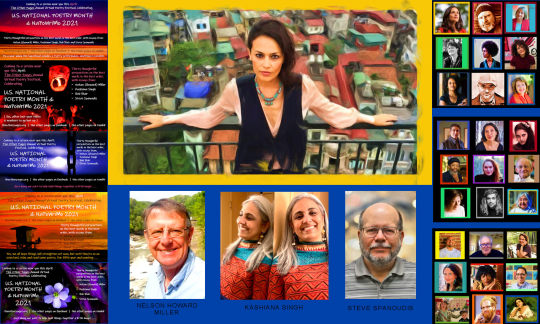
30 Essays on The Best Words in the Best Order, 2021 Edition
We did it. Thirty articles in just over 30 days, on many different aspects of poetry, from themes and contrasts to structure, meter, and rhyme, to metaphors and patterns, to breaking things down and building them back up, from expansive views to introspection. I hope you had a chance to enjoy at least some of the articles. If you didn’t, just a reminder that all 30 are archived on https://facebook.com/theotherpages and https://theotherpages.tumblr.com. I will comment that more of you may be Facebook users, but Tumbler is way better at indexing and presenting than Facebook. The Other Pages is also beautifully presented on Tumblr.
Sincere thanks to Kashiana Singh and Nelson Howard Miller for their help. We were without the services of Bob and Robin this year. Nelson actually did his articles while recovering from Covid, and Kashiana while moving across the country and participating in her amazing stream of other events.
The podcasts were a new experience for me, though Kashiana had done it before. They are archived on https://anchor.fm/steve-spanoudis.
For the record, while tallies continue, we will probably finish up with over 12,000 reads this year, and over 1,200 reactions and comments on Facebook. The most read article featured Maria Nazos and a poem about domestic abuse. Second place was a poem by Ladan Osman on a child’s perspective of racial disparities. Third place was Kashiana’s commentary on Laila Chatti.
This year’s pieces also focused more heavily on contemporary poets. This was educational and highly enjoyable for me, including the opportunity to listen to, meet, talk with, and even get to know some of the poets featured. Please note that the “other” Kashiana, Kashiana Sharma, does not exist. She is one of the virtual residents of The Republic of Dreams.
Yes, we’ll probably do this again next year (“Yay! We’re being renewed for another season!”), but I think I’ll need to draft some additional editorial help.If you’d like to volunteer, let me know.
A catalog of this year’s episodes is included below. If you’ve liked any of this, please SHARE on your favorite social media platform.
--Steve Spanoudis.
1. Denise Levertov - The Room
https://anchor.fm/steve-spanoudis/episodes/2021-NPM-01---Denise-Levertov-etm13r
2. Molly Peacock - The Flaw
https://anchor.fm/steve-spanoudis/episodes/2021-NPM-02---Molly-Peacock-ettvmq
3. Terence Degnan - the yes no
https://anchor.fm/steve-spanoudis/episodes/2021-NPM-03-Terence-Degnan-eu2bvk
4. Vassar Miller - Without Ceremony - article by Nelson Howard Miller
https://anchor.fm/steve-spanoudis/episodes/2021-NPM-03-Vassar-Miller-eu49ut
5. Ladan Osman - The Key
https://anchor.fm/steve-spanoudis/episodes/2021-NPM-05-Ladan-Osman-eu5vmv
6. Pat Mora - Curandera
https://anchor.fm/steve-spanoudis/episodes/2021-NPM-06-Pat-Mora-eu65og
7. Maria Nazos - Waitress in a Small Town Seaside Tavern
https://anchor.fm/steve-spanoudis/episodes/2021-NPM-07-Maria-Nazos-eubgl1
8. Hayden Carruth - The Ravine - article by Nelson Howard Miller
https://anchor.fm/steve-spanoudis/episodes/2021-NPM-08-Hayden-Carruth-eublto
9. Eaven Borland - Becoming Anne Bradstreet
https://anchor.fm/steve-spanoudis/episodes/2021-NPM-09-Eavan-Borland-eucpuc
10. Tishani Doshi - The Day We Went to the Sea
https://anchor.fm/steve-spanoudis/episodes/2021-NPM-10-Tishani-Doshi-eul1fc
11. Yolanda Wisher - sonnet w/ cooking lexicon
https://anchor.fm/steve-spanoudis/episodes/2021-NPM-11-Yolanda-Wisher-eun0hl
12. Laila Chatti - Deluge - article by Kashiana Singh
https://anchor.fm/steve-spanoudis/episodes/2021-NPM-12-Leila-Chatti-eun4c5
13. Tina Cane - Some Kinds of Fire
https://anchor.fm/steve-spanoudis/episodes/2021-NPM-01---Tina-Cane--Anna-Akhmatova-euriuc
14. Richard Blanco - La Florida Room
https://anchor.fm/steve-spanoudis/episodes/2021-NPM-14---Richard-Blanco-eutlfj
15. Michael Hamburger - Grape and Nut Letter - article by Nelson Howard Miller
https://anchor.fm/steve-spanoudis/episodes/2021-NPM-15-Michael-Hamburger-euv861
16. Ted Kooser - In the Basement of the Goodwill Store
https://anchor.fm/steve-spanoudis/episodes/2021-NPM-16---Ted-Kooser-ev0jd3
17. Keorapetse William Kgositsile - Anguish Longer Than Sorrow
https://anchor.fm/steve-spanoudis/episodes/2021-NPM-17-Keorapetse-William-Kgositsile-ev40s
18. Melissa Balmain - Love Poem
https://anchor.fm/steve-spanoudis/episodes/2021-NPM-18-Melissa-Balmain-ev653a
19. Kazim Ali - The Voice of Sheila Chandra - article by Kashiana Singh
https://anchor.fm/steve-spanoudis/episodes/2021-NPM-19-The-gleaming-work-of-Kazim-Ali---The-Voice-of-Sheila-Chandra-ev7kld
20. Nora Dauenhauer - Amelia’s FIrst Ski Run
https://anchor.fm/steve-spanoudis/episodes/2021-NPM-20-Nora-Marks-Dauenhauer-ev8fum
21. Vona Groarke - Still Life in Marble
https://anchor.fm/steve-spanoudis/episodes/2021-NPM-21-Vona-Groarke-evaoi4
22. Kashiana Sharma (f) - The View from Above
https://anchor.fm/steve-spanoudis/episodes/2021-NPM-22-Kashiana-Sharma-fictional-evek5o
23. Fred Marchant - This is What the Mind Does
https://anchor.fm/steve-spanoudis/episodes/2021-NPM-23-Fred-Marchant-evism2
24. Michael Torres - Because My Brother Knows Why They Call Them “County Blues,” but Won’t Tell Me Why
https://anchor.fm/steve-spanoudis/episodes/2021-NPM-24-Michael-Torres-evlgs6
25. Khaled Mattawa - Bedtime Reading for the Unborn Child
https://anchor.fm/steve-spanoudis/episodes/2021-NPM-25-Khaled-Mattawa-evn34c
26. Rita Dove - Dusting
https://anchor.fm/steve-spanoudis/episodes/2021-NPM-26---Rita-Dove-evpoaa
27. Rainer Maria Rilke - Go to the limits of your longing - article by Kashiana Singh
https://anchor.fm/steve-spanoudis/episodes/20201-NPM-27---JoJo-Rabbit-and-Rainer-Maria-Rilke-e100ihe
28. Naomi Shihab Nye - You are Your Own State Department
https://anchor.fm/steve-spanoudis/episodes/2021-NPM-28-Naomi-Shihab-Nye-e104bk7
29. Yonatan Berg - Unity
https://anchor.fm/steve-spanoudis/episodes/2021-NPM-29-Yonatan-Berg-e106cpl
30. Jane Hirshfield - Three Foxes by the Edge of the Field at Twilight
https://anchor.fm/steve-spanoudis/episodes/2021-NPM-30-Jane-Hirshfield-e106jed
The full text of all articles is available at The Other Pages mirrors
on Facebook: https://facebook.com/theotherpages
And Tumblr: https://theotherpages.tumblr.com
(scroll down for content on either page)
#national poetry month#napowrimo#2021#the other pages#theotherpages.org#Nelson Howard Miller#Kashiana Singh#steve spanoudis
1 note
·
View note
Photo
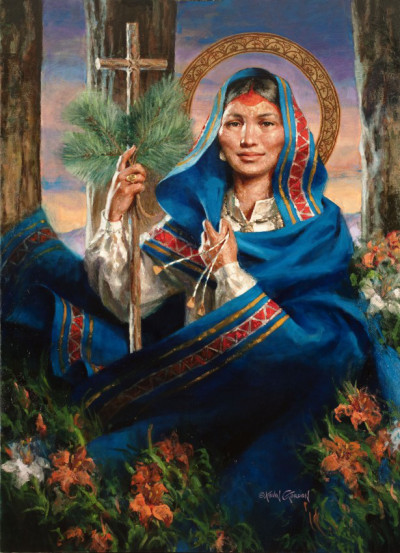
SAINT KATERI TEKAKWITHA: PRINCESS OF THE EUCHARIST
For many years, American Catholics who wanted to follow in the footsteps of a saint had to travel to Europe. In Assisi, they could step where Saint Francis did. In Ireland, they might walk the byways of Saint Patrick.
It wasn’t until the late-20th-century canonizations of Sister Elizabeth Ann Seton, born in New York City in 1774, and Sister Katharine Drexel, born in Philadelphia in 1858, that Americans finally had the opportunity to stay in the country when visiting places where U.S.-born saints lived and worked.
But the Big Apple and the City of Brotherly Love have changed significantly since the 18th and 19th centuries. In contrast, a virtually unspoiled place trod by a saint lies in upstate New York, thanks to the October 21 canonization of Kateri Tekakwitha, who walked and prayed in what is now the central part of the Empire State. In her time, it was the land of the Mohawks.
TRIBUTE TO THE NATIVE DAUGHTER
By making a trip to the Albany Diocese, people can visit two places associated with this Native American woman. The National Kateri Tekakwitha Shrine, located in Fonda, New York, and operated by the Conventual Franciscans, honors Saint Kateri’s baptismal site, while the Jesuit-run Shrine of Our Lady of Martyrs in Auriesville, New York, marks her birthplace.
The landscape where Kateri walked and prayed hasn’t changed, nor has the meaning of her life, according to Bishop Howard J. Hubbard of the Albany Diocese. Earlier this year, in the diocesan newspaper, The Evangelist, Bishop Hubbard paid tribute to the native daughter: “Despite the pristine simplicity of the civilization [Kateri] experienced and the rather drab ordinariness of her life, there are . . . some important lessons to be drawn from her pilgrim journey of faith,” he said.
First, she was “a woman who understood well and accepted with patient resignation the mystery of the Cross, that mystery which proclaims that our faith is founded on . . . the paradox of death leading to life; the paradox of suffering leading to glory; the paradox of defeat and failure leading to victory.”
Second, continued Bishop Hubbard, Saint Kateri was “a woman of magnificent fortitude, dogged determination, and unswerving conviction. A lesser person might well have yielded to the pressure . . . to squelch that thirst for the God of the Christians, which the Holy Spirit had so copiously stirred up in her heart.”
Finally, he said, Kateri was “a woman of great prayer, a woman who had a deep and abiding awareness of the Lord’s love for her and an ongoing personal relationship with him.”
COMMEMORATING THE CANONIZATION
Since its origin in 1847, the Albany Diocese has commemorated Kateri in several ways. Both the Knights of Columbus and the Catholic Daughters of the Americas have chapters dedicated to her. A diocesan program carries her name: Kateri Institute for Lay Ministry Formation. Most recently, two parishes that merged in Schenectady eschewed creating a portmanteau name from the titles of the former parishes and elected to become St. Kateri Church.
The two national shrines annually host multiple events that involve Native American Catholics. This year, the National Kateri Tekakwitha Shrine celebrated the saint’s feast day on July 14 with Native American rituals and songs. “I wanted to be in the place where she lived, where she was baptized, and where she is still honored,” said Eddie Ryder of Bay Shore, a town on Long Island. “I’m part Native American, and I’ve always wanted to come here and really feel Kateri’s presence.”
As Franciscan Father Mark Steed prepared to celebrate the feast-day Mass in a rustic pavilion on the shrine’s 200 acres of wooded land on the bank of the Mohawk River, he explained the significance of Kateri’s canonization for Native American Catholics. “It authenticates who they are as a people and who she was as an individual living all of those numbers of years ago,” he told Catholic News Service. “It gathers them in now to the whole Church. So they’re not sitting on the fringe. Now they are part of the inner circle.”
Four days later, more than 800 Native American Catholics from throughout North America flocked to the Albany Diocese to attend the 73rd annual Tekakwitha Conference. Holding the conference in Albany was a lucky stroke—or the intercession of a soon-to-be saint — because the event had been slated well before the canonization was announced. The conference, based in Great Falls, Montana, was started in 1939 as a way to unify Native American Catholics from different tribes across the United States.
Participants included members of the Mohawk, Choctaw, Algonquin, Navajo, Ojibwa, and other tribes. They listened to presentations ranging from the connection of Mother Earth and fracking to Native Catholic genealogy and a talk on Kateri as “a princess of the Eucharist.” Throughout the conference the smell of burning sweetgrass — known among native peoples as the “hair of Mother Earth” — wafted through Masses as congregants approached altars, offering corn, beans, and squash with the Eucharist.
Conference executive director Sister Kateri Mitchell, SSA, a Mohawk, said that the organization’s members, as well as other native peoples, routinely return to where the new saint was born and baptized because “there’s something intriguing about Kateri. She was born way back in the mid-17th century and died 24 years later. But in 2012, people still remember this Indian woman.”
WALKING ON HOLY GROUND
Sister Kateri’s own introduction to the new saint occurred when she was a child named Delia; she grew up on the St. Regis Mohawk Reservation, which straddles upstate New York and Canada. “My father would say on some mornings, ‘Let’s go back home.’ By ‘home,’ he meant the Mohawk Valley—Fonda and Auriesville,” she recalled. “He said that even though he had never lived there. The Mohawk people had not lived there for centuries. My father would tell the story of our people when we were there. It was like walking on holy ground.”
As the years passed, she came to love the shrines as much as her father did. “They attracted me,” she explained, and then echoed her father by saying, “It was like going home.”
Eventually, she entered religious life and chose Kateri as her name. When her order later permitted its members to return to their baptismal names, she consulted her parents. “My mother and father said, ‘Keep Kateri.’ It’s a very special name to me. I’m a Kateri more than a Delia.”
The uniqueness of the Kateri sites in upstate New York, she says, is that “they are so beautiful. Nature itself captivates you. People have told me they go there annually because they find a connection with nature and Kateri. It’s very peaceful and sacred. Saint Kateri calls people to deepen their own spiritual lives.”
In 1987, while visiting the United States, Pope John Paul II called Kateri “the best-known witness of Christian holiness among the native people of North America. . . . She always remained . . . a true daughter of her people, following her tribe in the hunting seasons and continuing her devotions in the environment most suited to her way of life, before a rough cross carved by herself in the forest. The Gospel of Jesus Christ, which is the great gift of God’s love, is never in contrast with what is noble and pure in the life of any tribe or nation, since all good things are his gifts.”
Sister Kateri believes that those good gifts include Saint Kateri and the land her people loved, where today’s Catholics can walk in her footsteps.
A SHORT HISTORY OF SAINT KATERI
When Kateri Tekakwitha was proclaimed Saint Kateri Tekakwitha on October 21, she became the first member of a North American tribe to be declared a saint. “The Lily of the Mohawks,” Kateri was born in 1656 in a village along the Mohawk River called Ossernenon, now known as Auriesville, New York. Her father was a Mohawk chief, her mother a Christian Algonquin raised among the French.
When Kateri was 4, a smallpox epidemic claimed her parents and baby brother. She survived, but her face was disfigured and her vision impaired. She was raised by her anti-Christian uncle, who began to plan her marriage. But after meeting with Catholic priests, Kateri decided to be baptized.
Following her Baptism by a Jesuit missionary in 1676 at age 20, Kateri’s family and village ostracized and ridiculed her. She fled the next year to Canada, taking refuge at St. Francis Xavier Mission in the Mohawk Nation at Caughnawaga on the St. Lawrence River, about 10 miles from Montreal, and made her first Communion on Christmas in 1677.
Kateri astounded the Jesuits with her deep spirituality and her devotion to the Blessed Sacrament. She took a private vow of virginity and devoted herself to teaching prayers to the children and helping the sick and elderly of Caughnawaga.
She died in 1680 at age 24. According to eyewitnesses, the scars on her face suddenly disappeared after her death. Soon after, Catholics started to claim that favors and miracles had been obtained through her intercession. Native Americans have made appeals to the Catholic Church for her recognition since at least the late 1800s.
Documentation for Kateri’s sainthood cause was sent to the Vatican in 1932. She was declared venerable in 1942 and in 1980 was beatified by Pope John Paul II.
Records for the final miracle needed for her canonization were sent to the Vatican in July 2009. It involved the full recovery of a young boy in Seattle whose face had been disfigured by flesh-eating bacteria and who almost died from the disease. His family, who is part Native American, had prayed for Kateri’s intercession. On December 19, 2011, Pope Benedict XVI signed the decree recognizing the miracle, clearing the way for Kateri’s canonization.
Written by: James Breig
111 notes
·
View notes
Text
#10 Best Online Nursing Schools in USA.........five star nursing | five star staffing | nursing assistant training | nursing career options
https://www.fsnursing.com/10-best-online-nursing-schools-in-usa/

Nurses give basic consideration in clinics, specialist’s workplaces, and other clinical offices around the country. As a sought after field, nursing gives chances to work development with better than expected pay rates. Numerous planned medical attendants depend on internet nursing schools to acquire their certificates and advance their professions.
An Overview A Online school contrasts from an in-person program in more ways than one, yet both give the preparation important to turn into an enrolled nurture, nurture expert, or other nursing proficient. While the particulars fluctuate contingent upon the school and program, this segment presents the design and configuration for internet nursing schools. Five Star Nursing best nursing staffing agency.
Here is the list of 10 Best Online Nursing Schools in USA
Ohio State University
Ohio State University is positioned No. 1 Best Online Master’s in Nursing Programs. Schools are positioned by their presentation across a bunch of broadly acknowledged marks of greatness.
Johns Hopkins University
Graduate nursing programs some of the time accompany weighty measures of examination, and John Hopkins University is maybe the best exploration college on the world. The exceptionally regarded school offers no undergrad nursing programs, however it has a MSN for non nursing majors.
Anybody who procured a four year college education in a non-nursing field can sign up for the MSN, and graduates succeed on the NCLEX.
New York University
In the New York City, New York University is genuinely a worldwide college with understudies coming from 133 distinct nations and grounds in Abu Dhabi and Shanghai. Understudies come from around the world to procure highest level training.
Georgetown University
As one of the most seasoned private foundations in the country, Georgetown University in Washington, D.C. has a laid out, very much regarded nursing program.
The BSN utilizes direct passage, meaning current secondary school understudies see whether they’ve been acknowledged into the BSN program prior to selecting at Georgetown. By graduation, BSN understudies will have acquired more than 882 hours of clinical involvement with areas across Washington, D.C., and the encompassing region.
University of Pennsylvania
Established in 1740, the University of Pennsylvania is among the most seasoned colleges in the country. The school flaunts a great 6:1 understudy to-personnel proportion, superb for nursing understudies searching for customized instruction.
Penn’s BSN has understudies learn in a cutting edge reproduction lab, and understudies enter a mentorship program to work on their experiential learning.
University of Michigan
Situated in the school town of Ann Arbor, the University of Michigan is perhaps the best spot to procure an undergrad training. The BSN degree works off north of 100 years of nursing schooling experience, and north of 13,000 U-M nursing graduated class work all over the planet.
The school sets up two choices for section: direct passage for first-year understudies and a sophomore exchange program.
University of California Los Angeles
Known for delivering top quality alumni who become innovators in their fields, the University of California Los Angeles is among the best foundations of advanced education in the West.
Nursing courses in the college’s BSN degree program establish the groundwork to either partake in a useful nursing profession or to progress forward and procure a graduate degree.
University of Maryland
College of Maryland is a forerunner in development and exploration.
The college shows more than 41,000 understudies every year, and its area close to Washington, D.C. furthermore, other significant urban areas makes it ideal for nursing understudies and future nurses.
UM’s BSN stresses nursing initiative and uses cutting edge offices to instruct understudies. The program requires just two years to finish, however understudies first need to follow through with two years of early on courses.
University of Washington
University of Washington has a few interesting advantages for nursing understudies.
To begin with, all understudies get to finish clinicals at many locales across the district, including highest level emergency clinics like Seattle Children’s Hospital. Second, nursing understudies can choose creative projects like the sped up BSN with early DNP confirmation, best for non-nursing graduates who need to acquire their doctoral certification rapidly.
Duke University
Perceived as one of the most amazing examination schools on the planet, Duke University offers a portion of the top nursing programs. The School of Nursing at Duke just offers just a single degree decision for undergrad nurture sped up BSN.
To sign up for this program, candidates first need to finish a non-nursing four year college education. In any case, the program requires 16 months to finish, requires just 58 credits, and understudies gain 800 hours of clinical experience prior to graduating. Results for the program are profoundly sure as well.
https://www.fsnursing.com/10-best-online-nursing-schools-in-usa/
https://www.fsnursing.com/nursing-assistant-training-services/
#nursing assistant training#Registered Nurse#nursing career information#nursing assistant jobs#nursing career paths#LPN JOBS#LPN jobs opportunities in USA
0 notes
Text
Grand Jeté - Ch 5 & 6
When George Warleggan quits a high powered job in the City to take care of the finances of the South West Ballet, run by his friend, Francis Poldark, it changes his life - even more so than he expected.
Elizabeth Chynoweth came to the South West to come back home, take on new challenges, and leave behind a less than perfect time in her life. She intends to focus on her art, but everyone knows what they say about best laid plans…
Ch 1 & 2 Ch 3 & 4
~
Chapter 5
The familiar jaunty melody was just beginning to leak out into the corridor as George approached the doors to the auditorium. It was the beginning of the climactic section of Rodeo and he intended to watch. Tonight was the final performance, and he’d already seen the show in full twice, but this was the fifth time he was going to watch the finale. As a perk of the job he not only got free tickets to any performance, but was allowed to watch from the usher’s seats if the hall was sold out, which it had already been for this entire run by the time he arrived.
The insulated doors could be opened and closed near silently for staff to enter and leave, so he was able to slip in without disturbing anyone. One of the volunteer ushers – mostly students from Truro & Penwith College and Falmouth Unversity – nodded a greeting before returning their attention to the stage. Front and centre, Demelza Carne and Malcolm McNeil performed an energetic duet, the skirts of Demelza’s Old West style dress flowing elegantly as she spun. This was the transformation of her tomboyish Cowgirl into the romantic heroine and she captured it perfectly. George had become intimately familiar with the themes and plot of this piece over the last few weeks. Frankly, he rather regretted not learning more about ballet when he’d been in London with Francis and Verity. Beyond the name of the ballets he’d seen – Coppelia, The Prince of the Pagodas and Firebird among others – he hadn’t taken much else in, apart from a general enjoyment of them. It was really quite a fascinating topic, and he’d found himself passing a whole evening reading up on Rodeo’s composer, Aaron Copland and original choreographer Agnes de Mille, and a half a dozen other related topics.
There was a momentary pause, the dancers flowing neatly into position as the orchestra struck up the first few notes of the piece George now knew was called ‘Miss McLeod’s Reel’. This was what he had really come for, as it was the accompaniment to Elizabeth’s brief solo. Even if he felt like a stalker, he hadn’t been able to resist watching this section more than once, although he’d refrained from coming more often. It was just that Elizabeth was so enchanting when she danced. The others were excellent, but there was just something about her that fascinated him. He hoped she never found out about his secret trips to the back of the auditorium – Heaven knew what she’d think. She’d been polite enough not to mention catching him peeking in at their practice, but this might be a bit much.
There was a smattering of applause as Elizabeth’s section came to an end and the main cast returned to the stage for the finale, a reprise of the ballet’s main theme, culminating in a romantic embrace between the leading characters. The entire company had been uniformly excellent, but it seemed that the fact it was the final night had given them some extra energy. It really was an impressive production, even more so now that George had an insight into everything that went on behind the scenes – by analysing the costs of each production he’d discovered just how many tiny details had to be considered. At first, he’d been appalled by how much was spent on ballet shoes, until he’d learned that a lead ballerina could wear out a pair in a single performance. He’d therefore managed to negotiate a discount with their supplier in return for being a named sponsor of next season’s programme.
Before the final notes of the score had even died away, or the lights fully dimmed, the audience were on their feet, clapping and cheering. The lights flared once more and the cast joined hands to take their bows, most stepping back to leave Demelza, Malcolm, Caroline and Ed Carkeek at the front of the stage. There was another wave of applause for the four of them, and two young girls from the corps disappeared into the wings, returning a moment later with large bouquets of flowers for the women. With a bit of encouragement from the stage, Francis emerged from the wings to yet more cheers from the audience. It was remarkable, really, that he could look so nervous taking a brief curtain call, when George had seen him throw himself without care about a stage wearing little more than tights and a vest. He certainly didn’t envy Francis at this moment. Ever since a terrifying experience in a Nativity play aged 6, George had studiously avoided anything related to the performing arts.
The ovation had gone on for quite a while in the end, and it was nearly two hours later before the closing night party was in full swing. Held in the backstage complex, it was a lively gathering, dancers hurrying about, some still in costume, almost all still in full make-up. The drinks flowed freely, cast and crew taking advantage of the fact they had tomorrow off before launching into a week of intensive final rehearsals for Dracula.
Francis had insisted that George and Rosina attend, along with all the other support staff. Although everyone was very nice and he’d been plied with champagne, Morwenna filling his glass nearly to over-flowing, he felt a touch out of place. He’d socialised with the dancers outside, but this was their domain, a complete contrast to their little paperwork-lined office.
“So, Francis tells me you knew each other in London?” He turned to find Elizabeth had appeared next to him. She’d traded her emerald green costume for a simple black dress, but she was no less striking in it. Her abrupt arrival and opening question had thrown him for a moment, but he managed to recover himself.
“Er, yes, but we actually met at school. Years ago. Sort of lost touch until we bumped into each other by chance while he was at Covent Garden.”
“Did you work there, as well?” He was temporarily distracted by her taking a pull on the straw in her drink and mentally chastised himself.
“Oh, no! I’ve –er – I’ve never actually worked in the arts before. I used to work for a private bank, actually.
“Wow, really?” She raised her eyebrows. “Like, hedge funds and things?”
“Yes, pretty much.”
“So, what made you come here? Surely you made a lot more money doing that? Oh no, that’s rude of me, sorry – “
“No, it’s probably a fair question!” He laughed. “I just, I suppose I wasn’t getting anything out of it, and I wanted a change. A new challenge. Or any challenge, actually!”
“I – “ She looked at him oddly for a moment and he wondered why he’d just blurted all that out to her before she suddenly smiled, soft lips curling attractively. “I know exactly what you mean.”
~
“Ah! There you are! Any progress?” The balletmistress, Anne, stuck her head around the door, raising her eyebrows at Francis. “Hello, George. Hello, Rosina.”
“Hello, Anne. Any progress on what?” George raised his eyebrows at Francis, but instead of answering, Francis merely sighed.
“We’re trying to decide on the programme for next season, with some difficulty. Francis obviously thought he could hide out in your office instead.” She came in and leant against a bookcase, smiling ruefully.
“I thought it was suspicious you suddenly wanted to discuss VAT returns….” He saw Rosina smirk behind her computer screen, despite pretending to be absorbed in her spreadsheets.
“Oh, it’s always difficult. We’re understaffed, is the problem.” Francis shook his head.
“Are we?”
“Yes, well, with male dancers. Since I’m only part-time, we’ve only really got two male principals: Malcolm and Hugh. They’re both fantastic, but they can’t be expected to lead a whole season. There’s just Paul and Ed in the soloists, and not many in the corps, either, so promoting someone wouldn’t really solve the problem.”
“It limits the productions we can do.” Anne explained. “We had enough of a nightmare casting Dracula with so many male parts. If Francis wasn’t participating, we’d be stuck. Lion’s tricky as well, but we’ve just about managed by getting Caroline and Keren to play male parts.”
“We could promote Ed, and advertise for a couple of new male soloists, but there’s no guarantee we’d get them by next season and we need to pick the productions soon so we can start costing them. Or rather, you can start costing them.”
“Well, perhaps George could give us layman’s opinion?” Anne said. “What would you say to Marie Antoinette? And Twelfth Night?”
“Sounds good, but….” He paused, before deciding to throw caution to the wind. “How about something Greek?”
“Greek?” Francis exchanged a glance with Anne. “Big fan of the classics are you, George?”
“No, it’s just – Well, I’ve had an idea…”
“What sort of idea?”
“I’ve seen from your records that you’ve performed in other venues before, although not for a couple of years, and there’s that open-air theatre in Porthcurno, the Minack. I’ve made some discreet enquiries, and they’d apparently like to get more dance and opera alongside the plays they usually stage, and they’ve not fixed their summer schedule yet. They’d take a portion of the profits, of course, but they’d also bear half the costs, and – I’m not an expert, I admit – but I think the cost of staging would be less than indoors – “
“Stop, stop!” Francis held up his hand and George took a breath, realising that he’d been rambling. The entire time he’d been looking into this idea, he’d been worried that he was overstepping the mark, but equally he hadn’t wanted to bring it to Francis without having at least tested the waters. Now, he was regretting it all. That is, until a smile slowly began to spread across Francis’ face. “George…that’s brilliant!”
“Really? You think so?”
“Yes! Frankly, I’m annoyed I’ve never thought of it myself.”
“We could do Spartacus!” Anne suddenly interjected. “It would be perfect in that setting! And it’s only got two main male roles, so no problems with casting.”
“Brilliant! Right, let’s go and speak to Ellen.” Francis sprang up before turning back to George. “Can you put together all the details for us, and then I’ll speak to the management there after we’ve hashed things out on our end? Or would you rather follow it up?”
“No, by all means, once the financial side is sorted out, it’s all up to you lot.”
“George, you are truly a genius.” He flashed a quick grin. “Or perhaps I’m the genius for bringing you here?”
With that, he and Anne disappeared in the direction of Ellen’s office. Still feeling a bit like he’d had a rug pulled out from under him, George sat back in his chair. Rosina glanced after her departing colleagues before turning to him with a look of excitement.
“That was a brilliant idea!”
“I have to admit, I wasn’t sure if they’d go for it.”
“They’d have been stupid not to.” She looked round guiltily after saying this, as if Francis and Anne might have still been lurking outside to hear her cast aspersions on their judgement. “I suppose that explains why you’ve been so cheerful these past few days, with that piece of genius floating around in your head.”
“Don’t be ridiculous.” With a shake of his head, he went back to his VAT return. He had been cheerful recently, but it had nothing to do with the Minack idea, although he wasn’t about tell Rosina the real reason: He had a date with Elizabeth Chynoweth.
Chapter 6
“…Elizabeth Chynoweth, so tragic and magnificent in last season’s Madame Bovary, makes for an equally spectacular Mina, her strength and determination shining through every step. She is the perfect counterpart to Caroline Penvenen’s delicate, tortured Lucy – delicate indeed! Never been called that before! – “ Caroline looked up from her phone and waggled her eyebrows, making Elizabeth and Demelza laugh. “The cast is uniformly excellent, from Hugh Armitage’s Jonathan and Malcom McNeil’s Van Helsing, all the way to the Weird Sisters, brought to fantastically creepy life by Demelza Carne, Margaret Vosper and Morwenna Chynoweth. However, there is no doubt about it – just as Bela Lugosi and Christopher Lee owned the character on the silver screen, this production absolutely belongs to Francis Poldark’s Count. Poldark has been less seen on the stage since he took over as the South West’s artistic director but if this is the kind of performance he’s going to deliver when he does appear, it’s well worth the wait in-between. Well! That’s the Cornish & Devon Post, but the others are much the same: Western Morning News, The Herald, The Cornishman, even The Gloucester Citizen and The Bath Chronicle!”
“Did you hear that, Morwenna?” Demelza tugged her gently to sit down with them. “We’re ‘fantastically creepy’”.
“Well, that is what all my school reports said.” Morwenna arched an eyebrow and Demelza snorted.
“Creepy you may be, but it seems we are all just background decoration for the great Francis Poldark!” Caroline made a put-upon face and then laughed when Elizabeth swatted her.
“Francis is fantastic and you know it. And it’s not like the reviews haven’t been highly complementary of you, as well.” Caroline couldn’t deny it. The reception for Dracula had been excellent, and not just in the traditional press according to Rosina Hoblyn, who George had put in charge of the company’s social media. Elizabeth had dropped by the administration office a couple of days ago to put her new mobile number on file – and secretly hoping to see George at the same time, although he was disappointingly out. She’d been surprised by the change that had come over Rosina, who had always been polite and friendly, but seemed to have a newfound confidence. She told Elizabeth that George had also designated her HR duties, so that he could focus on solely on the finance.
Elizabeth had to admit that – as stupid as it was – she felt a tiny twinge of jealousy listening to Rosina enthuse about George. Rosina simply appreciated being given a fulfilling job to do, just like anyone would. Besides, she and George hadn’t even been on their first date yet, she wasn’t about to go and get possessive.
She hadn’t been able to resist going over to talk to him at the Rodeo party. He’d looked a little lost amongst the flamboyance of the dancers, not to mention very attractive; in his shirtsleeves, top buttons undone and his neatly styled hair starting to fall over his forehead after the long day.
There had been a slightly awkward note between them the few times they had run into each other since that chance introduction in the corridor; even that odd, intriguing moment at the taxi, but not that night. She sensed he’d opened up to her a little more than he’d intended when she asked him about coming to the South West, but he hadn’t seemed embarrassed by it, and their conversation had flowed more freely after that. He’d complimented her dancing yet again – she heard such things often, and was always very grateful for them, but his obvious sincerity suffused her with a particular warmth. At a natural pause in their conversation, he’d turned to face her more directly and bit his lip, very distractingly, as if he were considering something.
“I – I don’t suppose you’d like to, maybe, go for a coffee sometime? Or something?”
It was as if whatever reservations she’d been having about getting involved with anyone had simply disappeared from her mind and, completely without hesitation, she’d told him she’d love to. The smile he gave her at that had lit up his face and she couldn’t help but return it. Their eyes met and for one wild moment she’d thought he was going to kiss her. She’d been just about to let him when Caroline appeared beside them.
“There you are! Wondered where you’d snuck off to. Oh, but, “she raised her eyebrows, “am I interrupting something?”
“No.” They’d said it in unison, entirely too quickly, causing a slow grin to spread across Caroline’s face.
“Well, in that case, I must apologise for stealing her away from you, George. Don’t worry, though, I’ll bring her back in one piece.”
“I wouldn’t count on it.” Elizabeth had muttered as Caroline led her away by the arm, to a relatively quiet area by the costume store.
“So…you and George, hmm? Tell me all about it.”
“There’s nothing to tell.” Caroline tutted at this answer. “There isn’t! We’re just going for a coffee, or something, that’s all…If you don’t mind, that is.”
“Of course I don’t mind! Why would I – “ Her blue eyes suddenly widened and her lips formed a perfect ‘O’ of understanding. “You think that we were – Oh ho, no! No, no, nothing like that. Not that I don’t think he’s great and you should absolutely go out with him, but we’re just friends.”
“You are?” Elizabeth suspected she hadn’t been able to hide her relief at that, since Caroline looked both amused and sympathetic.
“Yes! You remember that awful ex-fiancé of mine I told you about? Unwin? Well, he and George were at Oxford together; they were housemates, which I don’t envy George for at all, I can tell you! Unwin introduced us and we all used to socialise sometimes when I was in London. But since I split with Unwin and went to Milan, George and I have only really exchanged a few emails. You heard him – he’d even forgotten I was with the South West!”
“Yes…”
“Yes, so, stop worrying about me and start thinking of yourself. You need to get back in the saddle,” she paused, a twinkle in her eye. “If you know what I mean…”
“Caroline!”
~
She and George had both been busy the next couple of weeks, with Dracula among other things, but they’d managed to arrange to meet for lunch one Saturday. There were a few days between the first run of the ballet and the next and Francis had told them to take a break, since they would be going into full rehearsals for the de Valois double the following week.
Elizabeth spent a good two hours that morning going back and forth on what to wear. It was only a café lunch so she wasn’t going to get all dolled up, but equally it was a date with a man she really liked so she wanted to look nice. Eventually, she settled on simple black jeans and a soft cream jumper warm enough that she could go without a coat. It was getting into October now, but Cornwall always had milder autumns than the rest of the country in her experience.
She was a little early so ordered a coffee, the waitress greeting her with a friendly smile. The café wasn’t far from Elizabeth’s flat, and it had become something of a favourite. Just as she was taking her first sip, the bell over the door jingled and she looked up to see George standing in the doorway, looking around. It wasn’t a big place, so he spotted her quickly; she smiled and gave him a little wave, immediately thinking it made her look stupid, but George was smiling back as he came towards her, slipping off his light jacket to hang it over the back of the chair. The forest green colour of his jumper was very flattering. At the waitress’ approach, he indicated he would have the same as Elizabeth.
“You look nice.” Elizabeth felt herself blush and glanced away, wishing she could stop acting like a silly schoolgirl.
“Thanks…Did you find the place okay?” She wondered if she should have returned the compliment - he did look nice, very nice – but it was too late now and George didn’t seem to have noticed the omission.
“Yes, eventually. I still haven’t managed to find my way around properly, to be honest. There’s been too much to do. I’ve only just finished unpacking!”
“But you’re from Cornwall originally, aren’t you? You said you knew Francis at school.”
“Yes, at prep school, quite a long time ago now!” He laughed. “But we lived further out, near Penzance. I remember my Mum bringing me to Truro once when I was little, but I haven’t been back since.”
“Morwenna’s parents live near Penzance. At Gulval.”
“Oh, I know it! Mum used to visit an elderly lady there. A friend of the family.” He took a thoughtful sip of his coffee. “How did you and Morwenna both end up at the South West? Just by chance?”
“Yes, well, no.” Something inside her jumped instantly to the defensive, used to deflecting accusations that Morwenna was riding on her coat-tails; accusations which always seemed to bother her more than Morwenna. But George’s question was entirely sincere; he wasn’t a jealous professional rival or a bitchy arts journalist. “Yes and no. You probably know she was at the Ballet Cymru before? They’re a very good company but she didn’t think there were many opportunities to advance there. So, when I knew the South West was looking for some new dancers, I suggested she audition, but it was all down to Francis and Anne that she was taken on.”
“She’s very talented.”
“She always has been…” And Elizabeth told him the story of Morwenna’s very first ballet lesson, which led into her own first lessons. She told him about falling in love with dance, and her mother approving primarily because she could lord Elizabeth’s successes over her friends; this led onto her time at the Royal Ballet School with Francis and Verity, then joining the English National after that. When the waitress appeared to ask if they would like anything else, she realised that they’d both finished their coffees and she’d been waffling on for ages. “Oh God! Wow, I’ve just rambled on at you for I don’t know how long….”
“No,” George smiled. “I was interested.”
“We did come here for lunch, though, so perhaps we should eat something? The food here is really good.”
They ended up lingering over their sandwiches as much as they had over their coffees; with a little prompting, George encouraged her to continue where she had left off, and she told him about her 18 months with Ballet Zurich. It turned out he’d visited the city on business a few times and they knew some of the same places.
“Don’t you miss the travel, coming here? From jet-setting all over the world to…Truro?”
“Actually, it was partly the travel that turned me off. I mostly never got to see or enjoy anything, just a long string of endless meetings about essentially the same topics.”
“It’s a big leap to take, if you don’t mind my saying.” She had been curious about his reasons for leaving his old job, even after their talk at the Rodeo party.
“Yes,” he glanced down at his now empty plate with a smile. “Yes, it was. My father certainly wasn’t happy about it.”
“He’d have preferred you in London with him?”
“No, well, yes, but – ah – I actually left the family firm to come here.” Elizabeth felt her eyebrows raise. Wow, that really was daring. She was impressed.
“Oh my...Well, are you happy you came?” He looked her straight in the eye and smiled.
“Yes, I really am.” She couldn’t help but smile back, her stomach fluttering, and not because it was upset. When they were finally finished – George agreeing with her that the food was delicious – they stood for a moment on the pavement outside. “Would you like to walk those sandwiches off? You could show me around a bit?”
“I – oh no! I can’t!” She glanced at her watch. They had been there for nearly three hours! The time had flown by. “I’m supposed to be going to a Pilates class with Morwenna in half an hour. I would really like to, though, honestly. Maybe another time?”
“We could have Sunday lunch tomorrow?” She was surprised, and extremely pleased, that he’d want to see her again so soon, but he obviously took her hesitation the wrong way . “It’s only that you’re going to be busy again when Dracula resumes and I’ve got a lot coming up – “
“I’d love to.” He really did have the nicest smile.
‘Hoedown’ - Main theme from Rodeo The Minack Theatre
#poldark#george warleggan#elizabeth warleggan#elizabeth chynoweth#rosina hoblyn#francis poldark#morwenna chynoweth#caroline penvenen#demelza poldark#grand jete#au#f: ge#f: au#fic#m: fic
12 notes
·
View notes
Photo

“Paean to the People” | Directed by Lesli Linka Glatter
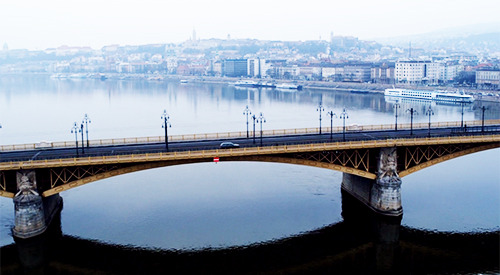
“Paean to the People” picks up right where “All In” left off. Carrie and Anson are speeding through the streets of Budapest Moscow Budapow. In this opening shot, their car is the only one on the bridge, adding to the feeling of just how on their own they are, without diplomatic cover, as they try to distract Yevgeny long enough to get Simone on that plane.
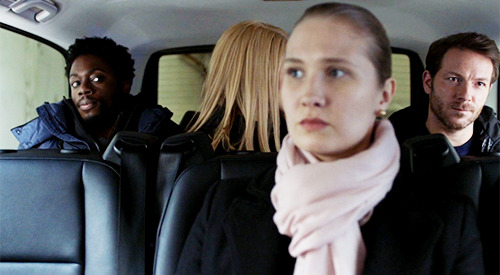
The arrangement in this shot!! Everyone whose face is visible is serving so much face. Simone is like, “don’t look at me.” Bennet (with facial hair!) is like, “are you fucking kidding me?” Doxie (with some pretty great side eye) is like, “I am NOT getting stuck in Budapow.” And Ms. Pink Scarf is like, “What am I doing here again? What is my job?” You and us both, Pink Scarf. You and us both.
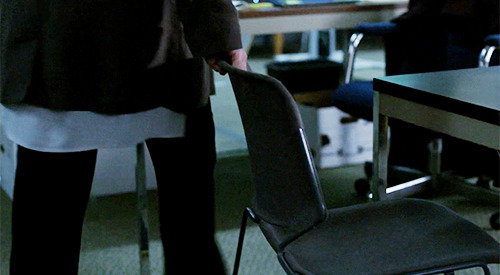
Let’s give a full round of snaps to Sandy this season. She brought the sassy realness and Russian know-how the whole dang time. This show needs all the female energy it can get and this shot of her pulling out the chair for Clint’s “time out” is incredible. We’re not sure if she’ll be back for season eight, but if she won’t, we will miss her so.
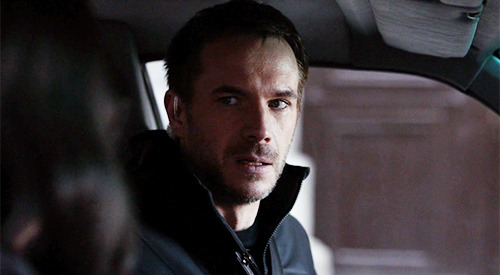

Both Carrie and Anson know what’s at stake in this mission but in this moment, it’s Carrie who has to convince Anson how far she can and will go. We hate to say it, but the moment of recognition shared here between them screams “America First” when Quinn tells Carrie to get in the car and stay down. If seven seasons of Homeland have taught us one thing, it’s that these people all follow the same code: Get in. Get down. Shut up. Mission over self.
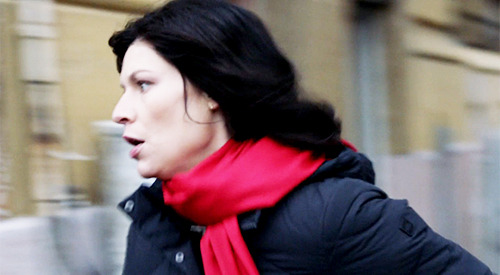
IJLTP.

We will hand it to the Homeland props department for getting the birthday right on Simone’s fake Carrie Mathison passport (it’s April 5, 1979). But!! Her middle name is spelled Anne, not Ann.
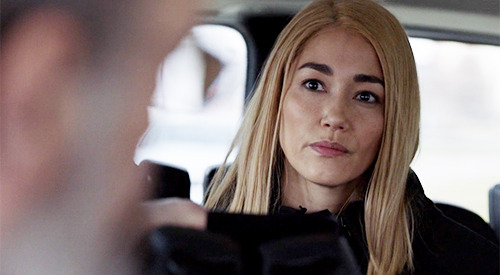
Simone spent a lot of time obscuring her face from the Russian officials in that car, but this glimpse of her expression after she asks Saul if he’s really going to leave Carrie--the Carrie who CLIMBED A FUCKING ROOF LIKE TWENTY MINUTES AGO TO GET TO SIMONE--in Budapow. That is a pursed lip and evil eye if we ever saw ‘em.

...And, of course, the guilt is written all over his face.
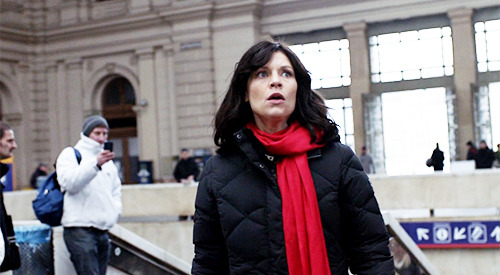
We are CACKLING at the dude in the white jacket in the background. We are not sure if he is just a really bad extra or some random stranger who saw Claire Danes in a Budapest train station and needed to share else he was met with a chorus of “pics or it didn’t happen” from his friends.

Sara and Doxie have the same birthday (November 4), which further solidifies that he is her forever man and the best Carrie Angel of them all.

We talked about the strong “America First” vibes above and the whole sequence of Carrie running through the train station is giving us heavy “The Smile” vibes, too. After seven seasons, it’s difficult for some moments not to feel like explicit callbacks from earlier episodes. After all, maybe looking at a mirror in a crowded marketplace is just Carrie’s favorite American spy woman move. But this shot, and Carrie’s smile later, are so specific that we think the homage is intentional.
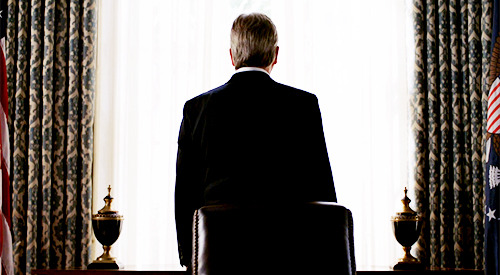
IJLTP, II.
Real talk though, you really get a sense of the loneliness of the office here, as Beau faces away, back to the camera, surrounded by those heavy curtains.

Lesli Linka Glatter is a choreographer by training and she’s talked before about the diligent preparation she does before directing a Homeland episode. In sequences like these--filmed, acted, and edited with such specific clarity--that training and preparation come through loud and clear. Every shot has a purpose and we’re exposed to all angles of the action. It really is like a dance.
Here, the slow reveal of Yevgeny coming around the corner ratchets up the stakes as Carrie waits, a sitting duck in the locked room.
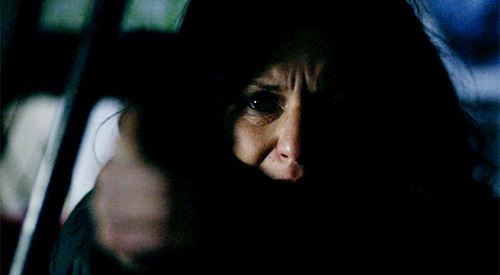
And here’s our duck. What’s so great about thrilling and suspenseful action sequences like this is the human moments they’re contrasted with. We can see the fear in her face as she contemplates whether to go down in a blaze of glory. She’s not made of steel. She may only have seconds left to live. She may be a hero but she is not a superhero.

Yevgeny delivers a BudaPOW (sorry, we couldn’t resist) with his punch to Carrie, but her moment of defeat is quickly transformed into one of triumph with the news that Saul and his “package” have achieved lift-off.
This smile, guys. Damn. Claire Danes is in a class all her own.

Delirious, glorious laughter. When was the last time we saw Carrie laugh?
It doesn’t last long, of course. The first rule of Homeland is that if Carrie smiles, shit’s about to get fucked up. “At least she had this moment,” we all whisper quietly to ourselves.
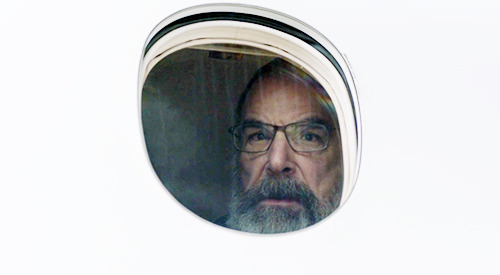
The shots of Saul looking down from his window at the city of Budapow--Carrie in it God knows where, the proverbial needle in the haystack--are powerful. He has left her there. And now he has to get her back.
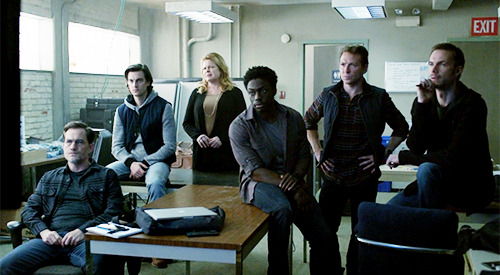
We love this shot of everyone arrayed out like this, watching Simone’s testimony in The Room Where It Happened. Though we would like to point out that it’s hard to take Bennet seriously without facial hair. Dude, it’s 5 o’clock somewhere. Get on it! (Also there are so many VESTS this season! We count two in this shot alone.)

IJLTP, III.
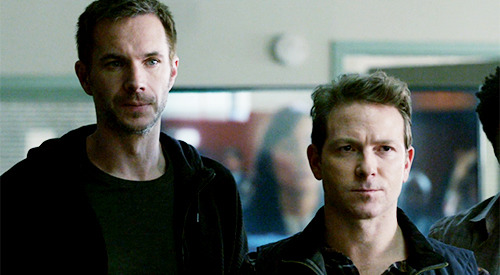
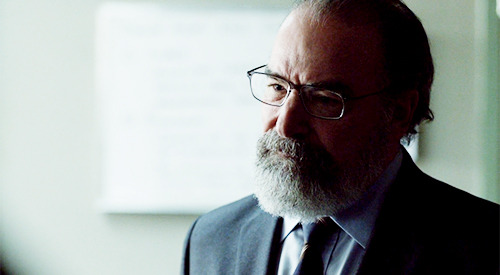

This is the sequence of shots after Keane says she’ll do everything she can to get Carrie back. There was some chatter about going to Anson first (looking pensive), then Saul (looking sorrowful), and finally Max, who looks the most doubtful and suspect of them all (and, of course, almost hidden behind the others in the back). Sara actually thinks closing with Max is the most powerful. He’s been by Carrie’s side, through thick and thin, all seven seasons of this show. And after the trauma of losing Quinn last season, it’s easy to see how history may be replaying itself for him, this time in agonizing slow-motion.


So many “Pilot” vibes. This show loves playing with reversals and bookends, and having Carrie be the prisoner now is one of the most stinging of them all.
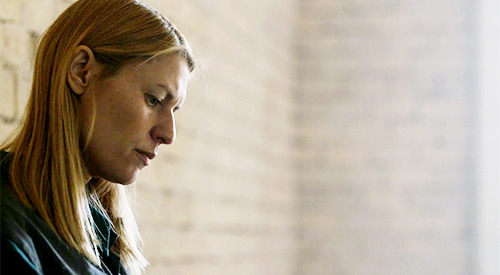
Sara would just like to say that she even looks beautiful in a Russian prison.
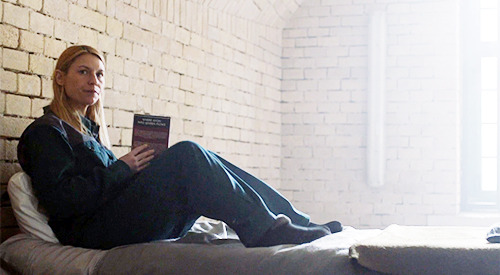
The book Carrie’s reading here is called Where Avon into Severn Flows, which is actually a short story by the American writer Harold Frederic and part of his book The Deserter and Other Stories: A Book of Two Wars.
Here is the opening paragraph of the story:
“A boy of fifteen, clad in doublet and hose of plain cloth dyed a sober brown, sat alone at one end of a broad, vaulted room, before a writing table. The strong, clear light which covered him and his work fell through an open window, arched at the top and piercing a stone wall of almost a yard's thickness. Similar openings to the right and left of him marked with bars of light a dozen other places along the extended, shelf-like table, where writers had now finished their day's labor, and, departing, had left covered horns of ink and cleansed utensils behind them. But the boy's task lagged behind fulfilment, and mocked him.”
It’s easy to see the parallels. Carrie is held in a Russian prison, also dressed in plain, ill-fitting clothes. She sits in a broad, vaulted room with a plain writing table nearby. Carrie might have won the battle, getting Simone back to the United States, but here in this cell, her success must feel fleeting and the irony of her current circumstance mocking.

Some major “There’s Something Else Going On” vibes here. (Sorry, we’re just gonna point out all our vibes.)

We’re just gonna call this pose from Costa Ronin the Yevgeny Lean (#IJustLikeHowHeLeans). On a more serious note, some credit needs to be given to Ronin, who brought Yevgeny to life and made him feel like a fully lived-in person. His habit of leaning back, feet propped out before him, is just one small example, but it’s representative of the care and attention he put into crafting such a three-dimensional portrait of one of the most interesting villains in the series’ history.
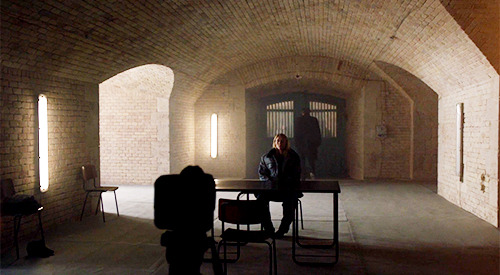
IJLTP, IV.
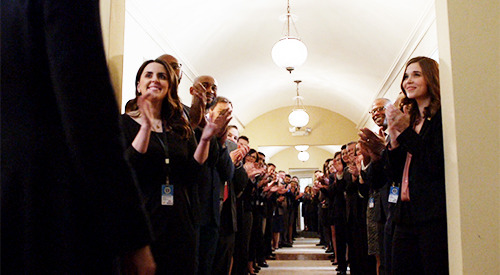
And that IJLTP shot of Carrie, alone in that Russian prison with the stakes (i.e., her mental health) now clearly defined, is followed by the rather astounding hero’s welcome that awaits Keane back in the West Wing. This reminds Sara of those tunnels that sports teams would form after a game for everyone to run through. And now Sara wishes Keane had run through the tunnel, high-fiving everyone.
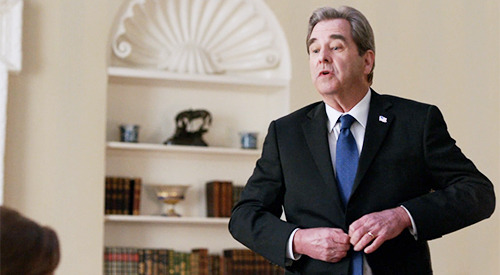
It’s Tie Color Time! Note that Beau is now back to the blue tie, having resumed his position as Vice President.

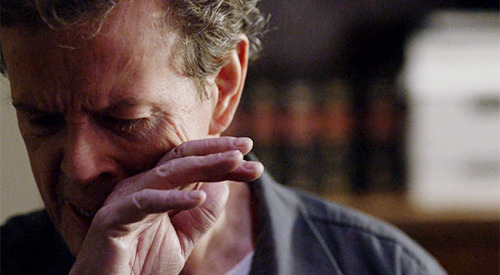
Talk about sweet karma. The scene between Paley and Keane is remarkable for a few reasons. First, Paley does all the talking. Keane doesn’t even give him the respect that comes with a response. He lowers himself to his knees, literally begging for her mercy.
Keane is often shot from below, highlighting her stance and power. But here, it’s a point-of-view shot. We see what Paley sees: this woman, whom Saul once claimed could not “rise above her own vindictiveness,” closing in on him, a bird of prey who’s finally made her catch. And then she spits in his face.
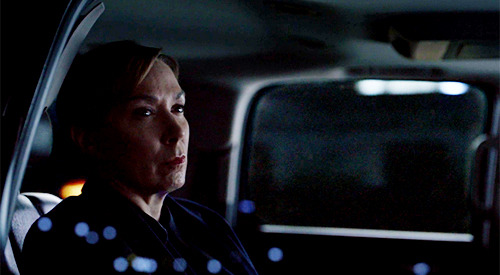
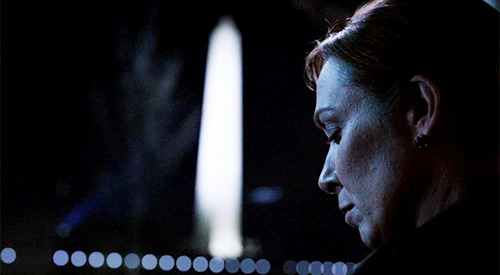
The Washington Monument, which sits due east of the Reflecting Pool, adds great dramatic effect to this beautifully shot (and scored) moment after Keane leaves her meeting with Paley. Despite the monument’s great size, in these shots its height matches Keane’s, which is likely intentional.
As the monument was being completed. Joseph R. Chandler, a Freemason and member of the House of Representatives said:
“No more Washingtons shall come in our time ... But his virtues are stamped on the heart of mankind. He who is great in the battlefield looks upward to the generalship of Washington. He who grows wise in counsel feels that he is imitating Washington. He who can resign power against the wishes of a people, has in his eye the bright example of Washington.”
As she drives back through the DC streets at night one last time as President, she’s clearly at a crossroads. History has its eyes on her. (We will also continue to make ALL the Hamilton references.)


We’re not sure if this moment was scripted or if it was a choice by Claire in the moment. Either way, what’s happening? If she praying? Thanking God? Carrie’s relationship with religion and atonement has been basically nonexistent since the show devoted attention to it in season five. We wonder if, like Brody before her, she may be discovering--or rediscovering, as it were--it while in captivity, a salve for her inevitable isolation.

A few things to note from this headstone:
It’s the tenth anniversary of Andrew’s death.
Are we really meant to believe Keane is old enough to have had a kid in 1979? Elizabeth Marvel was born in 1969, which means she’s playing at least ten years older than she actually is. Sara does not buy this, but whatever.
Andrew is born mere weeks before Carrie, which in hindsight kind of shifts the relationship between Keane and Carrie in season six. Carrie really could be Keane’s daughter, and if Carrie indeed did see her in some small part as a mother figure, it frames her conflict with Saul last season--and the battle for Carrie’s loyalty--in an even sharper light.
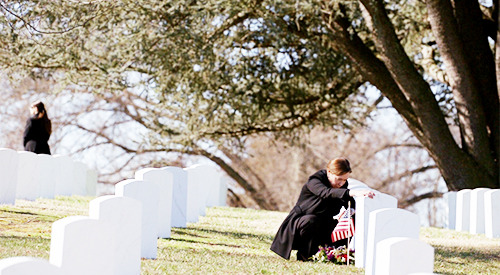
This is just a gorgeous light, the rows of headstones filling the bottom half of the screen and the large, overgrown tree framing Keane in the top half. It’s her figurative “moment alone in the shade” (figurative because she’s not really in the shade, but y’all catch our drift).
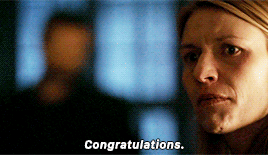
Again, it was impossible to properly capture the moment when Carrie congratulates Aleksandr through anything other than a gif. The quiver in her voice, her attempt at a forced smile. After this moment, the lighting in the room shifts--she is literally forced to see the light, as the direness of her circumstances are fully revealed.

This is the last time we see Carrie before the “seven months later” coda, so now’s as good a time as any to talk about the truly tremendous work she did this season.
From the opening episode, Claire took us on the tenuous, tumultuous journey of Carrie’s war with her own mind and the battles waged within. Every episode, every moment was brought to life with exacting precision. Sometimes we loved her, and sometimes we hated her, but Claire’s commitment to every moment never wavered, whether it was seducing Dante, having nightmarish visions of her bloodied daughter, or inching her way across that GRU roof.
The throughline of this season of Carrie’s mental health makes this moment and the final scene land with even more crushing weight than they otherwise would. When Carrie experiences a breakdown so harrowing and frightening, she goes to extreme lengths to restore her own sanity. In the last three episodes of the season, we see just how invaluable that sanity is--her mind is both her greatest asset and greatest liability.
Carrie knows here what’s about to happen. She stares, eyes wide open, almost as if she’s glimpsing into the future at what lies before her. There’s no safety net this time, no pills or ECT to pull her back or hit the reset button. But for as much as she knows that she’ll lose her mind (in every sense of the word, it turns out), there is also great uncertainty, looking into “the bottom of a black hole with no walls.”


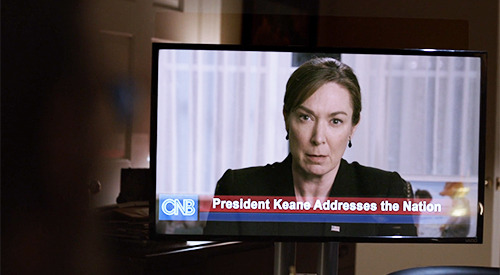

Something we find super interesting about this sequence is just how many perspectives LLG gives us of Keane’s speech, whether it’s Wellington’s from inside the Oval, Saul in his office, or Yevgeny in Budapow. Again, LLG’s choreography background comes shining through. For almost the entire speech, we see her presidency--and what turns out to be its final moments--through everyone’s lens except her own.
LLG doesn’t shoot Keane center-frame, without some extra filter of a screen, until the very end of the scene, after the speech is over. Keane talks earlier about wanting to speak directly to the American people, from the heart, but what we actually get is everyone looking at screens, at the filtered version of this woman and her office, a metaphor if ever there was one for her short-lived presidency.
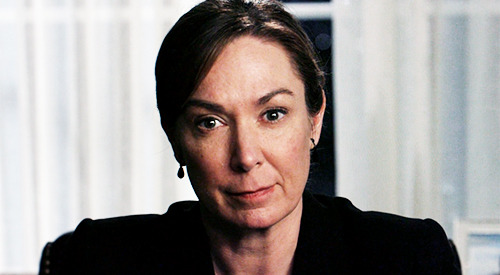
As her speech (which, like Washington’s Farewell Address, focuses on the need to not let political parties and divisions tear apart the country) nears its end, we do see Keane center-frame. But, again, it’s a shot of her center-frame on the screen, and her appearance is somehow altered and filtered.
(A quick note about her wardrobe: Keane starts the day grieving for her son at Arlington, and she keeps on the same black clothing during her speech, a signal of the impending end of her presidency. The dangling earrings are also an interesting choice, and an unusual one for Keane, who usually wears studs or conservative-looking hoops. Like Carrie in “Species Jump,” this is as close as she’ll get to “letting her hair down,” and the unconventional jewelry choice conveys the peace she’s found with her decision.)
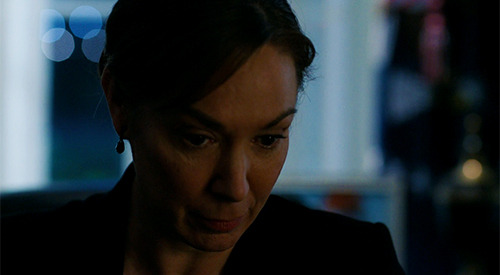
And now the lights come down on Keane and her presidency, in every sense of the word.

The dynamics of this scene remind Sara of the end of “The Choice,” when Saul sees Carrie in that hall of dead bodies after thinking she’d died in the explosion. They shared a moment of recognition at the end of that scene, standing in stark contrast to what unfolds here.
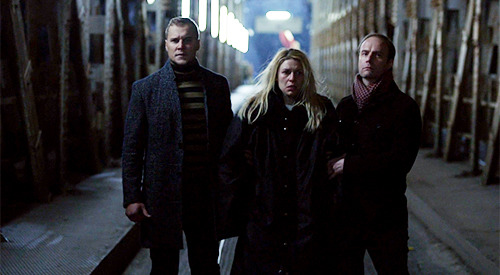
Here’s our first good shot of Carrie, and there’s a lot to take in. The swollen face and unkempt hair are startling, to say the least. Under her bulky black coat she’s wearing white (you can see a peak of her shirt here but her pants--not visible in this shot--are also white), indicating she’s been in an asylum.

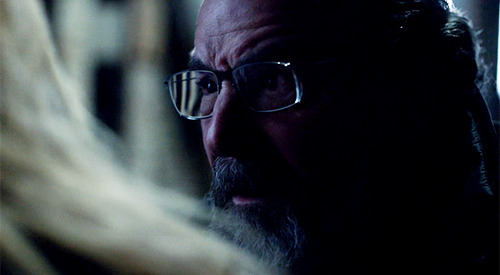
The season opened with Carrie running on a treadmill, athletic and strong, the buzzy chords of jazz blaring in our ears. It ends with our heroine on the complete opposite end of the spectrum. She’s feeble and unsteady, running away from the Russian guards and straight past Saul. We hear jazz again, but it’s slower and somehow weightier.
As Saul gently brushes the hair from her face and looks into her eyes, calling her name, she is seemingly unable to recognize him. Her eyes dart from side to side, up and down, but his remain steady on her, and we can see (and share) the concern and devastation etched on his face.
She’s searching, and so is he.
#homeland#homelandedit#paean to the people#lesli linka glatter#*#in the director's chair#by: sara#by: gail#vibes on vibes on vibes
17 notes
·
View notes
Text
Malcolm & Marie and the Rise of Quarantine Filmmaking in COVID
https://ift.tt/3p29Il0
At the start of the COVID-19 pandemic, a time when accomplishing even the simplest tasks had taken on the burden of the impossible, Netflix’s “secret pandemic movie,” Malcolm & Marie, became a way to process a year of stalled projects and compromised creative control. A Deadline feature retraced how Zendaya, one half of the two-hander’s cast, reached out to Euphoria creator Sam Levinson with the plea for a self-contained project when COVID delayed the HBO drama’s new season.
As Levinson rushed to write a script based loosely on his own experiences of failing to thank his wife at a movie premiere, he and Zendaya brought on Tenet star John David Washington for a movie at the complete opposite end of the spectrum from Christopher Nolan’s blockbuster; the Euphoria crew, in a COVID bubble in California, were able to keep working for a few weeks in June 2020 when so many others were laid off. What they created was a passionate, claustrophobic black-and-white relationship drama that has the rare distinction of being created during a pandemic while its story still reflects life before the virus.
On its own, Malcolm & Marie falls somewhat short of Oscar bait expectations. However, the film takes on greater nuance when considered in the context of the growing subgenre of post-lockdown movies. While this may ultimately prove to be a short-lived category of filmmaking, it already includes four incredibly varied films. Even if they all started with the same universal constraints—COVID tests and social distancing, small casts instead of big—they make for radically different statements about human connection (either during the pandemic or not), futility, about purpose.
In fact, you can plot these four movies over the axes of ignoring COVID versus acknowledging COVID in their actual plots, and closeness versus distance in the execution of said stories.
Malcolm & Marie
Ignoring the Virus and Embracing the Closeness of Quarantine
What’s immediately ironic about Malcolm & Marie is that its setting is anathema to our current situation: The eponymous couple come home from a movie premiere (remember those?), where he (Washington) is being celebrated as a rising Hollywood talent, and she (Zendaya)—an amateur actress, a recovering drug addict, definitely not a model—has been reduced merely to his loyal girlfriend. Their feature film-length fight might take place within the bounds of their spacious rented house, but every source of conflict and sticking point exists out in a non-pandemic world.
At the same time, the viewer is tangentially aware of the real-world limitations in filming this movie, i.e. the need to stay in one setting with only two players. The inability to leave that house–except for Marie’s desperate little steps of leaning out the window to smoke or of that ambiguous ending–is authentic to anyone who has been stuck in a relationship-defining fight: There are no shortcuts, no escapes; the only option is to see it through to the ugly end, only to watch the toxic cycle start all over again.
The actors’ close attention and shaping of their roles lends Malcolm and Marie’s relationship real intimacy, but it also contributes to the sheer exhaustion of watching these young lovers metaphorically eat their own tails without getting anywhere. Despite Malcolm’s appalling outbursts and Marie’s stunning monologues, nothing really changes; even his quiet “I’m sorry” at the end is a puny concession after all that emotional effort.
In fact, this ouroboros feels most like a reflection of the endlessly unfruitful fights that many a couple has experienced since lockdown began.
Locked Down
Acknowledging the Virus and Embracing the Closeness of Quarantine
By contrast, Mr. & Mrs. Smith director Doug Liman’s Locked Down casts its marquee stars (Anne Hathaway and Chiwetel Ejiofor) as ordinary people in the extraordinary circumstances of early 2020, when a pandemic that people still didn’t fully understand reshaped their home into a workspace, and work into a prison rather than an outlet. Steven Knight’s script—written in July 2020, on a dare—carries so many authentic field notes that it’s almost difficult to watch. You feel it from Zoom fatigue, with wine o’clock creeping up into the AM, to people talking over one another on video calls where they’re ostensibly checking in on each other.
Liman also employed the same amusing device used by the Parks and Recreation COVID special, in which real-life couples had to explain why their characters happened to be inhabiting the same physical space during this era of highly negotiating personal contact. In Locked Down, it’s Psych star Dulé Hill and his costar (and real-life wife) Jazmyn Simon as the sympathetic American counterparts to Linda (Hathaway) and Paxton (Ejiofor), an American and a Brit who are not holding up well enough in quarantine. (A bevy of cameos, including Mark Gatiss, Mindy Kaling, Ben Kingsley, and more also scratches that itch of wondering what celebrities’ homes might look like.)
Paxton and Linda’s marriage seems to have ended around Christmas 2019, but being stuck in their flat just as the pandemic hit—he’s a driver unable to work while she’s a CEO who has the excruciating duty of firing her “family” of coworkers over Zoom—has beaten their senses of purpose to a pulp. Paxton attempts to make up for that by making the masked grocery runs and trying to connect with his neighbors through shouted evening poetry, but he’s suffering the all-too-familiar depression of the furloughed. Linda isn’t far behind when she finally confronts the soullessness of her corporate job.
When fate delivers the incredible coincidence of Linda overseeing the load-out of a priceless diamond from Harrods—with Paxton assigned to transport the goods—the estranged couple decide to embark on a heist, because truly what else are you going to do during a pandemic? Ultimately, Locked Down does a better job with the romantic dramedy aspect than the heist, yet its use of the iconic London department store is as ambitious as Ocean’s 8 with the Metropolitan Museum of Art. Though there are more twists to the movie’s character studies than the logistics of nicking the diamond, the scenes in which Linda and Paxton stroll through the deserted Harrods food court—which arguably carries just as many culinary treasures—provide that same breathless sense of getting away with something.
Both films were made with unprecedented levels of safety and sacrifice, which regardless of the final products’ quality will always set them apart from pre-COVID entertainment as successes in filmmaking. But then there are the COVID films that have embraced social distancing, building it into a plot point or stylistic device rather than employing movie magic to obscure it.
Host
Acknowledging the Virus and Embracing Social Distancing
Interestingly, one of Levinson’s early pitches to Zendaya was a horror film, although of course they eventually pivoted to relationship drama. Fortunately, another enterprising group of creatives went the horror route, and they managed to fold in a poignant tale of female friendship over digital distances in 2020’s Host.
A British found footage successor to Paranormal Activity told entirely over Zoom, this indie tale has a shockingly reasonable premise: Five girlfriends, bored to tears during lockdown, decide to conduct a séance. (Again, what else are you going to do?) But when sarcastic Jemma (Jemma Moore) fakes a backstory about a suicidal friend and their medium Seylan (Seylan Baxter) mysteriously drops the call, the girls are on their own as a demonic force crosses over into the physical plane… and into each of their flats.
Read more
Movies
Upcoming Movies in February 2021: Streaming, VOD, and Theaters
By David Crow
Movies
Jurassic World 3 Photos Released as Production Resumes
By David Crow
In the past year, we’ve all learned that Zoom calls can be awkward, boring, and occasionally revelatory—but this is the first time they’re truly scary. Host utilizes the familiar horror tropes of darkened rooms and whispered panting at the slightest of suspicious noises, but it takes on an utterly disturbing dimension when it’s five young women, in the prime of their lives, are all trapped at home apart from one another—not even that far, as Jemma and séance enthusiast Haley (Haley Bishop) live within walking distance of each other.
In found footage fashion, there are plenty of Paranormal Activity-esque moments of people getting dragged or lifted by otherworldly forces. Kudos to director and co-writer Rob Savage for remotely directing his actors, who had to learn how to do the aforementioned practical effects inside their own homes. But where Host is scariest is when it leans into Zoom technology, from a chilling use of silly facial filters to a sequence that will make you reconsider ever making a custom video background for your future Zooms.
As the demon begins picking them off at random, with the others watching in helpless horror, Jemma’s shift from apathetic nonbeliever to selflessly trying to save Haley is incredibly moving. There’s so much history to this fractured friendship that you’ll be rooting for them to reconcile, even as you realize Host’s final trick: It’s only as long as an unpaid Zoom session.
How It Ends
Ignoring the Virus But Still Embracing Social Distancing
You could make the argument that Daryl Wein and Zoe Lister-Jones’ pre-apocalyptic comedy could be interpreted as taking place during COVID, what with its many comedy stars all acting a conspicuous six or more feet from one another. It’s just that even if that were true, it wouldn’t matter, because there are bigger fish to fry. Specifically, an asteroid en route for Earth, conveniently set to make impact at the end of Liza’s (Lister-Jones) and everyone else’s last day in sunny Los Angeles.
Trying to make it to an end-of-the-world party in LA without her car, which has been stolen, Liza and her younger self (Devs’ Cailee Spaney) wander through the aggressively bright county, populated with other people doing their best to cope. Unlike the other films on this list, How It Ends makes no effort to hide that it was shot with stringent COVID protocols enforcing social distancing: Cameos from the likes of Fred Armisen and Lamorne Morris are shot on different floors of houses while Bradley Whitford is so far removed in his scene that it’s impossible to get him and Lister-Jones in the same shot.
How It Ends is more a series of loosely-connected sketches than a super cohesive narrative, but that’s how the film manages to bring in so many talented stars as kooky strangers whom the two Lizas encounter, from Nick Kroll as the shadiest of drug dealers to Olivia Wilde as Liza’s estranged psychic friend (a scene-stealer) ,to Ayo Edibiri (another absolute delight) as a teacher who decided, hey, why not try her hand at stand-up comedy while she still can? Even with this layer of grim humor, get ready for this movie to spark unexpected pathos in these Decameron-esque encounters between strangers. By leaning into the physical distance between these characters, How It Ends shows how even when faced with the literal apocalypse, humans will still hold themselves apart from one another. While Liza makes peace with a number of key figures from her life, by the time the asteroid is creeping its way to the horizon, she is faced with her most challenging, but also most freeing, task: To accept that it’s okay to just be alone with yourself during a world-changing catastrophe.
cnx.cmd.push(function() { cnx({ playerId: "106e33c0-3911-473c-b599-b1426db57530", }).render("0270c398a82f44f49c23c16122516796"); });
The post Malcolm & Marie and the Rise of Quarantine Filmmaking in COVID appeared first on Den of Geek.
from Den of Geek https://ift.tt/3rMMkKf
0 notes
Note
Thoughts on ITV's new "darker" Pride and Prejudice? I'm assuming that this will bring onstage what Austen alludes to (i.e. Wickham). Do you think there's merit in explicitly showing the darker underside that exists in Austen? (I'm thinking along the lines of the "Anne with an E" retelling of Anne of Green Gables.) Or do we really need anything "darker" and "edgier" right now? And if we are going to highlight the "darker" side of P&P, is ITV/Nina Raine the vehicle to do that?
I’m not really familiar with Raine’s stage work so I can’t speak to what themes she may be likely to use, though it’s interesting that her work has been off and on associated with Roger Michell (1995 Persuasion director,) but that association could have negligible effects in terms of what we ultimately get, on-screen, and Michell himself is in no way associated with the project at this point. (Actors in minimal or no make-up? Pffffft not on ITV, c’mon now.)
I’m more excited about the gritty reboot of the CBC’s and Netflix’s Anne series for two reasons–the broadcasters and the source material. (Also the first season of Anne is out there for judgement, already, whereas we barely have any names firmly attached to the new P&P, yet.) ITV…is not in the period drama business for world-changing hot takes. I am not re-opening the can of worms that are my thoughts on Downton Abbey (though I lay more blame at the feet of Julian Fellowes than the network, honestly,) and their more recent work with Victoria seems to be more miss than hit; and I’m frankly not that enthused about the forthcoming Vanity Fair. Regardless of who is scripting the adaptation, the producers and director(s) will, I feel, have ultimate control over the final product. I won’t argue that the CBC or Netflix are revolutionary simply by contrast, but they have at least put out some interesting work, of late.
Anne, as well, touches on darker themes in ways that Pride and Prejudice does not. Anne Shirley is an abused and vulnerable child, and the books examine a lot of the deeply-rooted cultural prejudices that can make a bucolic small town in 19th century Atlantic Canada a nasty place to be if you’re an orphan, a girl, or in any other way an ‘outsider’. (Rachel Lynde is a canon bigot, not just a comic relief busybody.) Are some of the plotlines a bit squirrelly? Yes, yes they are, but they’re still largely worth watching if they have a point to make.
By contrast, the issues faced in Pride and Prejudice have much lower stakes. Everyone is grown (Lydia is marked out as a silly ‘girl’, but in her context she is treated as a young woman,) and the ultimate conflict is tied up in the policing of her sexuality. Wickham is indeed a predator, but are they going to make it a thing about girls in their teens, specifically? Because Pride and Prejudice is maybe not the best narrative to use to explore the sexual exploitation of minors. The disastrous effects of Lydia’s elopement on her family are what are explored, not the elopement itself. That’s over in a moment–reputations are that brittle. From the instant she sets out alone in Wickham’s company, that so-called fall from grace is done. In making P&P ‘gritty’ and ‘dark’, I presume they’re just going to make the illicit sexual contact more highly visible, a-la Andrew Davies’ adaptation of Sense and Sensibility featuring Eliza Junior on-screen because SEDUCTION SELLS but at the end of the day even if you cast an older actress that is still a supposed fifteen year-old being represented in a sexualized style with an older man, which will also be the case for Lydia. It’s troubling even if the minor ostensibly ‘consents’, and it’s traumatic if she doesn’t. (Oh my God, don’t do that, this isn’t a competition to make everything Game of Thrones.)
Also, as I’ve said before, we have so many adaptations of Pride and Prejudice, it’s just…this is so unnecessary. The story and characters are just not the appropriate vehicle for protofeminist and political commentary as we saw in Rozema’s Mansfield Park, and it’ll probably be the most hamfisted thing if we have to watch them try. The stakes aren’t high enough to make P&P all that gritty. If you want a gritty P&P, read Jo Baker’s Longbourn where people actually suffer from more than a heavy case of Feelings and Being Wrong About Shit. (Contrast it’s been decades since we had a live-action mainstream adaptation of Anne of Green Gables so if filmmakers WILL continue to adapt classics rather than commissioning new material, fine, it’s time, give us a fresh take on Anne.)
Austen has potential to explore darker undertones in her characters and stories. Pride and Prejudice is nowhere near my first choice for a narrative in which to do so, and I don’t expect ITV to bring more to the table apart from a lot of heavy breathing and blue filters to drench out the lighting with melancholy.
24 notes
·
View notes
Text
FRIENDS: Why we’re still in love with this charming and lovable gang? #SquadGoals.
Friends is a successful American television sitcom, which includes Jennifer Aniston, Courteney Cox, Lisa Kudrow, Matt LeBlanc, Matthew Perry and David Schwimmer as part of the show’s main characters. The TV sitcom revolves around the interesting and unpredictable lives of the six 20–30-something friends who live in Manhattan.
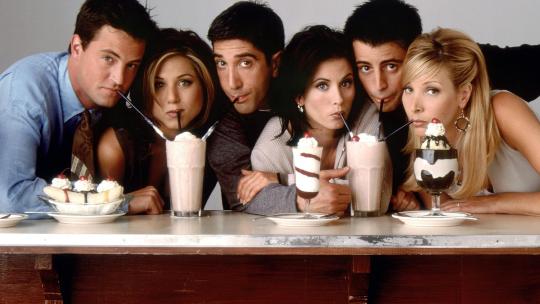
The hit series was created by David Crane and Marta Kauffman, and was aired on NBC from September 22, 1994, to May 6, 2004, lasting ten seasons. It has already been 23 years since the show was out and to this day, MY FRIENDS are still loving this hit TV show. I cannot even begin to explain how this show had turned my life around. The six talented actors/actresses had their different kinds of contributions to the show that only the six of them could ever fulfill. And just like any other success story there were a lot of setbacks and struggles for the show but they still pulled through and lasted with 10 seasons.
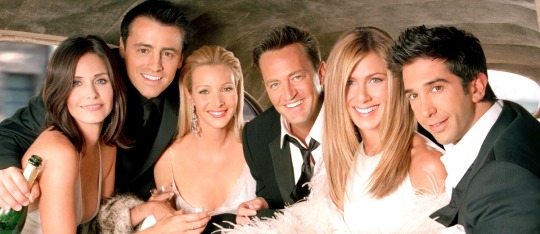
One of these struggles included Jennifer Aniston and how she was almost replaced for the show due to filming commitments with the short-lived series, Muddling Through. She has people calling her saying that they are auditioning for her part as Rachel Green and she struggled with the back-and-forth from Sony to Warner Bros. for two weeks. Luckily for the 45-year-old actress, Muddling Through only lasted three months so she was able to keep the role of Rachel, but confessed producers almost made her play Courteney Cox's character, Monica. Jennifer said: “They wanted Courteney to play Rachel, and unbeknownst to each other, I wanted to play Rachel and she wanted to play Monica. It worked out perfectly.”
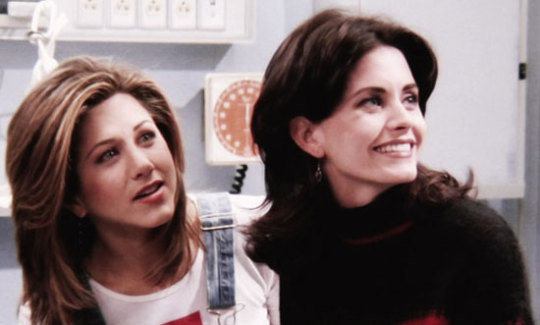
Another struggle for the show was the unexpected rehabilitation of Matthew Perry. Behind the sarcastic and witty persona Matthew Perry played as the famed Chandler Bing — the former "Friends" star was battling a serious addiction to drugs and alcohol. He really opened up about his struggles during the hit show's 10-year-run.He reflected on his routine alcohol abuse and a jet-ski accident in 1997, which led him to the use of prescription drugs. "Here, take this,” the actor recalled of a physician telling him at the time."I did and I felt better than I ever felt in my entire life. I had a big problem with pills and alcohol, and I couldn't stop." Perry was cast on "Friends" when he was 24-years-old and entered rehab twice during his rise to fame. The cast was raking in an unbelievable $1 million per episode."I was on 'Friends' from age 24 to 34. I was in the white-hot flame of fame. The six of us were just everywhere all the time," Perry told People’s Magazine."From an outsider's perspective, it would seem like I had it all. It was actually a very lonely time for me because I was suffering from alcoholism." And though he was having a battle between his use of alcohol and drugs, the cast and the whole production did not allow him to be left in that state and had helped him through his personal crisis and not giving up on him. Soon he had recovered and had gained the weight he had lost and was able to start his life the RIGHT way.
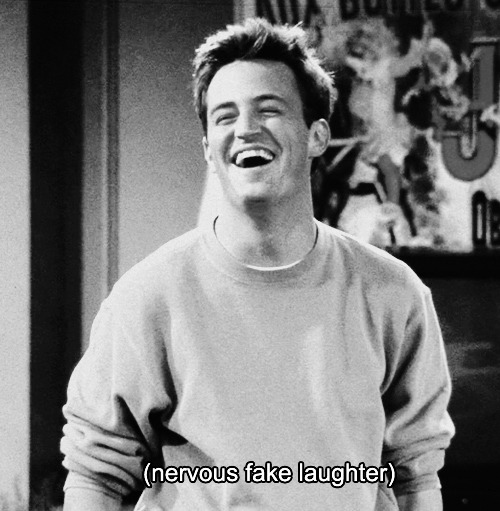
And other few minor things that they’ve gone through were Ellen DeGeneres turned down the role of Phoebe that was played by Lisa Kudrow, the renaming of the series countless of times and the show was originally intended to be called Insomnia Cafe but producers thought it wouldn't catch on. It was then renamed Friends Like Us, and then Six of One before finally becoming simply Friends, and then there was a time where Lisa Kudrow got pregnant and was unable to get out of work so the storyline of Phoebe carrying her brother's triplets was only written because Lisa Kudrow was pregnant in real life and can’t take a time out from filming, another struggle would be the part where some casts like Jennifer Aniston had to work with people she didn’t like and unfortunately for Reese Witherspoon who was signed up for around six episodes, got cancelled because apparently Jennifer Aniston disliked her and asked the producers to fire her.
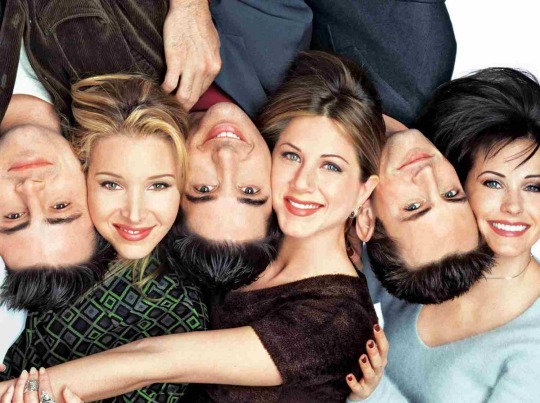
Some of the other struggles of FRIENDS are actually still present in today’s topics of society like their view about how Chandler's transgender father is often referred to as her birth name 'Charles' rather than her new name 'Helena Handbasket'. Incorrect labels are used when the cast are talking about her, lots of jokes are made about her gender and whether she has a penis, and there is definitely a bigger issue throughout the sitcom with transphobia. Another would be the racial diversity in Friends that had always been a topic of contention. Considering how multicultural New York is, it's interesting that the 6 main characters all happen to be white, straight and middle class - and with the exception of Charlie aka Ross' paleontologist girlfriend, named black characters barely appear for more than three episodes in a row at a time.
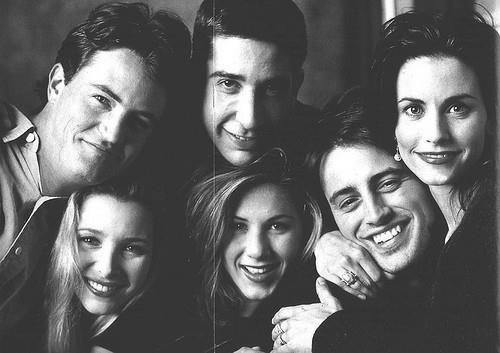
Early reviews of the series were mixed; and it holds a Metacritic score of 59 out of 100, based on 20 sampled reviews, indicating "mixed to average reviews." Tom Feran of The Plain Dealer wrote that the series traded "vaguely and less successfully on the hanging-out style of Seinfeld",while Ann Hodges of the Houston Chronicle called it "the new Seinfeld wannabe, but it will never be as funny as Seinfeld." In the Los Angeles Daily News, Ray Richmond named the series as "one of the brighter comedies of the new season", and the Los Angeles Times called it "flat-out the best comedy series of the new season."
But despite those kinds of setbacks the show truly won our hearts with their talented portrayal of their characters and with the relatable and random scenarios in life. And what makes it so lovable is that there really was a connection and a bond between the cast. The writers were also very good and their story lines were very unpredictable. The characters also showed versatility towards the complex situation given by the writer and what’s great is that they had fun and left a piece of them in their characters and how they stick to each one’s individuality.

Rachel Green’s character (Jennifer Aniston) is a naive runaway bride who reunites with her childhood best friend Monica and relocates to New York City, Rachel gradually evolves from a spoiled, inexperienced "daddy's girl" into a successful businesswoman. During the show's second season, the character becomes romantically involved with her friend Ross, with whom she maintains a complicated on-again, off-again relationship throughout the entire series. Together, the characters have a daughter named Emma.
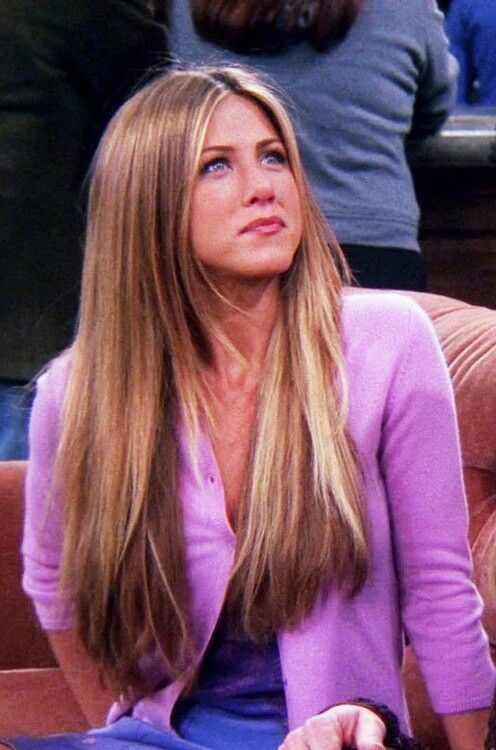
Monica Geller’s character (Anne Cox) is a chef known for her cleanliness, competitiveness and obsessive-compulsive nature, Monica is the younger sister of Ross and best friend of Rachel, the latter of whom she invites to live with her after Rachel forsakes her own wedding. The two characters spend several years living together as roommates until Monica begins a romantic relationship with long-time neighbor and friend Chandler, whom she marries. Unable to conceive children on their own, the couple eventually adopts twins and moves out of their apartment into a larger house in the suburbs.
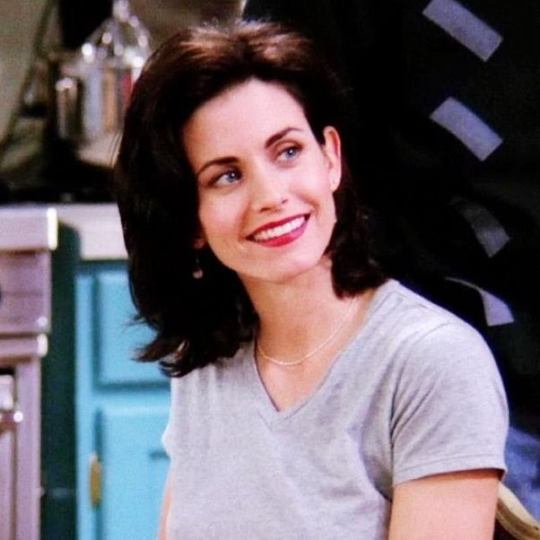
Phoebe Buffay’s character (Lisa Kudrow) is a masseuse and musician, notable for her offbeat and sometimes ditzy behavior. She was Monica's roommate before Rachel. She plays guitar and sings at Central Perk. During the show's ninth season, Phoebe is introduced to Mike Hannigan, played by actor Paul Rudd, by Joey, and the two begin a romantic relationship. The two later get engaged, then married. She is the daughter of Frank Buffay and Lily Buffay and her birth-mother's name was Phoebe Abbott. She has a twin sister named Ursula Buffay. She can speak several languages like French and Italian.

Joey Tribbiani”s character (Matt LeBlanc) is portrayed as promiscuous, and dim-witted, but good-natured, as well as very loyal, caring, and protective of his friends. He's a food-loving womanizer who has had more luck with dates than any of the other group members. In contrast to his "ladies man" personality, he has also a marked childish side. He enjoys playing video games and foosball. He loves sandwiches and pizza. He is a big fan of Baywatch. As a struggling actor, he is constantly looking for work. He was ordained as a minister in "The One with the Truth About London", and officiated at both Monica and Chandler and Phoebe and Mike's weddings. He does not like sharing food and has difficulty with simple mathematics.

Ross Geller’s character (David Schwimmer) is a paleontologist and has a Ph.D. from Columbia University. He is known to refer to himself as "Dr. Ross Geller." An ongoing theme of his narrative arc is his romantic feelings toward Rachel Green, an infatuation that began in high school. A theme of Friends is their on-again, off-again romantic relationship. His character is considered by many to be the most intelligent member of the group and is noted for his goofy, pathetic but lovable demeanor. He is a compulsive liar to avoid arguments or situations with conflict, often leading to an arcing story line within a show. His relationship with Rachel Green was included in TV Guide's list of the best TV couples of all time, as well as Entertainment Weekly's "30 Best 'Will They/Won't They?' TV Couples".
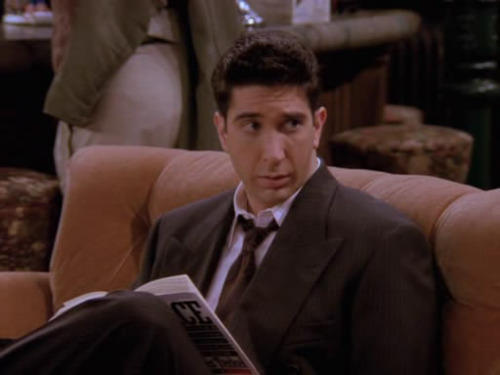
Chandler Bing’s character (Matthew Perry) works as an IT procurements manager with the specialization "Statistical analysis and data reconfiguration," but loathes it. In Season 9, he quits his job and Monica helps him secure a job in advertising through an old colleague friend of hers.Chandler is Ross Geller's roommate in college. Chandler met his friend Rachel Green while celebrating Thanksgiving with the Geller family during his first year at college. On a tip from Monica, Chandler later moved to Apartment #4 in Greenwich Village, Manhattan, across the hall from Monica and her roommate Phoebe Buffay. Actor Joey Tribbiani moves in with Chandler, who becomes his best friend. Chandler has a very good sense of humor, and is notoriously sarcastic. He is the highest earning member of his friends circle on account of responsible income management, having learned the value of money from a young age. He suffers from commitment issues, but later marries Monica. He is afraid of dogs.
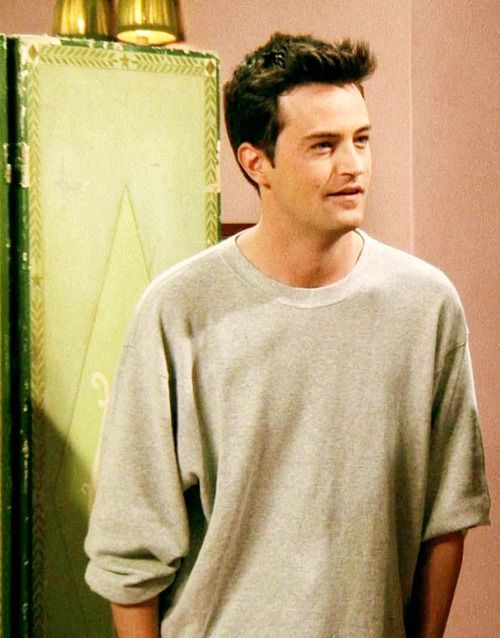
Their individuality and great personalities had really captured our hearts with every episode. I had never known a cast that had been so well fitted for each other than the cast of FRIENDS. They all just mix and complement well with each other. The beloved show has been greatly accepted and admired by over 2 generations already and it will continue to be loved by the generations to come. They had won over several awards both for the show and for the characters individually in which they have been given the chance to earn over 22 MILLION per season! They became so wildly popular and everyone just adored them and I AM ONE OF THOSE PEOPLE.

After 10 seasons of laughter, some tears, and some more laughter, "Friends" still remains one of the best shows to ever air on television. It has been nominated over 60 times for an Emmy, and won six. We could all agree that the reason behind their success was the connection and relationship these individuals have and their commitment to their work and how much they love portraying the roles. We could all see their essence through their characters and how passionate they are with their acting. And what makes this show believable is that they show their differences and still work things out. I don’t see them acting to be honest, what I want to believe is that they really are the characters because most of the time, everything they do seems so natural and life-like that it seems impossible for me to believe that they are just pretending. From the Chemistry to the relatable issues. They all just seem to be real to me.
Their presence and the whole show makes us want to be part of their gang. No matter the difficulty or complex their situations are, they’re still together and moving forward. And as I watch their last episode, I was in tears for I felt like I was saying goodbye to my FRIENDS. I felt like I grew up with them and that connection will forever remain and be shared with others towards the years to come. The show may have ended years ago, but it’s spirit lives on. And I wanted to share this post for others to know how amazing I think they are, and how billions of people have been touched by this adorable group of friends who will always be in my heart drinking coffee while sitting down on that big old couch inside Central Perk. With their success and their downfalls, I will always say I am proud that they’re MY FRIENDS.
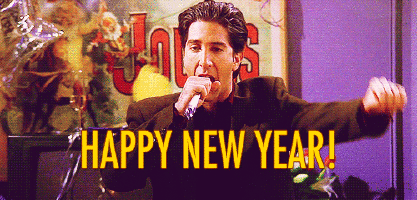
I hope you guys enjoyed reading my post and please do follow me on other social media sites to get more update from Definitely Zoey:
@martinzoeyyy (Twitter)
@definitely_zoey (Instagram)
Alyssa Martin (Youtube)
Till next time guys! I WISH YOU A HAPPY NEW YEAR!
3 notes
·
View notes
Text
POLITICO Playbook: Hurricane Trump at the G-7
New Post has been published on https://thebiafrastar.com/politico-playbook-hurricane-trump-at-the-g-7/
POLITICO Playbook: Hurricane Trump at the G-7

SCOOP — ANDREW DESIDERIOandELIANA JOHNSON: “House Judiciary Committee to subpoena ex-White House aide Rob Porter”:“The House Judiciary Committee will subpoena former White House staff secretary Rob Porter, a key witness in former special counsel Robert Mueller’s obstruction of justice investigation into President Donald Trump, as the panel weighs whether to recommend articles of impeachment.
“Porter, who resigned his post last yearamid allegations that he abused his two ex-wives, was at the president’s side during several episodes of potential obstruction chronicled in Mueller’s 448-page report on Russian interference in the 2016 election and Trump’s attempted to thwart the probe.
“The White House is likely to block Porter from complyingwith the committee’s subpoena, which seeks public testimony.” POLITICO
G-7 WRAP-UP…
— THE LATEST ON CHINA: “Trump says serious trade negotiations with China to begin,”by AP’s Zeke Miller and Darlene Superville in Biarritz, France: “President Donald Trump, under pressure to scale back a U.S.-China trade war partly blamed for a global economic slowdown, said Monday that the two sides will begin serious negotiations soon. Trump said his trade negotiators had received two ‘very good calls’ from China. He did not say when the calls were made and he declined to say whether he is in direct contact with President Xi Jinping.
“Trump said the conversations were a sign that Chinais serious about making a deal following the latest tit-for-tat tariffs between them. ‘I think we’re going to have a deal, because now we’re dealing on proper terms. They understand and we understand,’ Trump said as he met with Egypt’s president on the sidelines of the Group of Seven summit in France. ‘This is the first time I’ve seen them where they really want to make a deal. And I think that’s a very positive step,’ Trump said.” AP
BUT, BUT, BUT — BLOOMBERG’S MELISSA CHEOK (@mkcheok):“JUST IN: China’s Foreign Ministry spokesman Geng Shuang says has no info on phone calls to U.S. cited by Trump, adding later ‘I can tell you clearly that I haven’t heard of such a thing’ * Says China will protect itself on trade if U.S. persists with current approach.”
— STATE OF PLAY: “G-7 summit set to end with little consensus amid Trump’s mixed messaging on the trade war,”by WaPo’s Toluse Olorunnipa, Michael Birnbaum and Damien Paletta in Biarritz: “[A]s the summit entered its final day, there was little sign that Trump and other world leaders had reached anything nearing a consensus on thorny issues including trade, climate change, and how to deal with Iran, North Korea and Russia.
“Illustrating the growing divide between world leaders,the French all-but-abandoned efforts to craft a joint statement at the end of the summit, cognizant of how the United States is drifting further away from other nations on a growing number of issues.” WaPo
— NOT ON THE PRESIDENT’S PRIORITY LIST: L.A. TIMES’ @EliStokols:“Trump attended a G7 working session on Syria security issues but missed the one about climate, biodiversity and oceans. Other leaders attended both.”
— FROM 30,000 FEET: NYT’S PETER BAKERin Biarritz:“Rule 1 at the G7 Meeting? Don’t Get You-Know-Who Mad”:“For a day, at least, everyone was on their best behavior when the cameras were on, eager to present a show of bonhomie after so many previous meetings ended in discord. But behind the scenes at the annual gathering of some of the world’s leading powers, President Trump still found himself at odds with his counterparts on Sunday over issues like trade, climate change, North Korea, Russia and Iran.
“Ever so gingerly, as if determinednot to rouse the American’s well-known temper, the other Group of 7 leaders sought to nudge him toward their views on the pressing issues of the day, or at least register their differences — while making sure to wrap them in a French crepe of flattery, as they know he prefers.
“It was far from clear the messages were received,or in any case at least welcome. Like other presidents, and perhaps even more so, Mr. Trump tends to hear what he wants to hear at settings like this, either tuning out contrary voices or disregarding them. Through hard experience, other leaders have concluded that direct confrontation can backfire, so they have taken to soft-pedaling disagreements.” NYT
— POLITICO EUROPE’S DAVID HERSZENHORNandRYM MOMTAZ: “Macron’s G7 descends into summit of spin”
MARKET WATCH — “Global Stocks Fall as Trade Tensions Escalate,”by WSJ’s Shen Hong and Steven Russolillo: “Global stocks and government bond yields fell on Monday as a fresh escalation in the U.S. trade war with China, followed by conciliatory moves over the weekend, cast fresh doubt on growth prospects. China’s Shanghai Composite Index shed 1.1%. …
“On Monday, investors’ concerns about the impact on global tradeplayed out in the markets. U.S. futures tied to the S&P, which were briefly negative on Monday, turned positive after Mr. Trump said China had called U.S. trade officials and asked to ‘get back to the table’ for talks. Investors are losing faith in how both sides are approaching the trade war and whether a resolution could be reached soon, according to Peter Atwater, a research analyst and adjunct lecturer at William & Mary in Williamsburg, Va.” WSJ
TRUMP’S TAKE — @realDonaldTrumpat 7:30 p.m.: “In France we are all laughing at how knowingly inaccurate the U.S. reporting of events and conversations at the G-7 is. These Leaders, and many others, are getting a major case study of Fake News at it’s finest! They’ve got it all wrong, from Iran, to China Tariffs, to Boris!” … “My Stock Market gains must be judged from the day after the Election, November 9, 2016, where the Market went up big after the win, and because of the win. Had my opponent won, CRASH!”
Good Monday morning.
FIRST IN PLAYBOOK —STEVE BULLOCKis announcing a slew of staff and senior policy advisers later today, including Maura Matthews as national finance director and Mark Spengler as senior adviser and chief of staff for finance. Bailey Mohr is coming on board as digital director. James Wise will be policy director, and Marc Heinrich will be deputy policy director.
Bullock is also announcing more than a dozen policy advisers,including Chris Lu, Anne Slaughter Andrew, Andrew Shapiro, Frank Rose and Tracy Stone Manning.
WHAT THE … AXIOS’ JONATHAN SWANandMARGARET TALEV:“President Trump has suggested multiple times to senior Homeland Security and national security officials that they explore using nuclear bombs to stop hurricanes from hitting the United States, according to sources who have heard the president’s private remarks and been briefed on a National Security Council memorandum that recorded those comments.” Axios
— JUST SAYING … AP:“Forecasters say the fourth tropical storm of the Atlantic hurricane season is maintaining its strength as it moves toward the Windward Islands. The U.S. National Hurricane Center said Sunday that Tropical Storm Dorian could intensify to near hurricane strength over the eastern Caribbean Sea by Tuesday.”
BURGESS EVERETTin Old Town, Maine:“Inside Susan Collins’ reelection fight in the age of Trump”:“Shortly after Barack Obama won and Susan Collins was reelected in 2008, the president invited her to the White House to pitch the economic stimulus. It was not particularly subtle. ‘He said: “You know Susan, they really like me in Maine. And I did really well in the last election,”’ Collins recounted over sandwiches at the Governor’s Restaurant in Eastern Maine. ‘I practically had to bite my tongue in two to avoid saying: “They do like you Mr. President, but they liked me better.”’
“For Collins to win a fifth term, she needs Mainers to again like hermore than the current White House occupant. A whole lot more. The 66-year-old political giant is facing the race of her life despite her universal name recognition and bipartisan reputation. President Donald Trump is targeting Maine as a battleground while his divisive politics has cleaved the state in two, and Collins has to share the ticket with him. …
“Projected to be the most expensive in Maine’s history,the race is of imperative importance for party leaders and the Senate institution itself. With scarce opportunities elsewhere, Senate Democrats essentially need [Sara] Gideon to win to gain a minimum of three seats and the majority. In the Senate, a Collins loss would be a potentially fatal blow to the reeling center of the chamber.” POLITICO
2020 WATCH …
— MARC CAPUTOin Seattle:“‘The rock star’ vs. ‘The rock’: Warren and Biden hurtle toward collision”:“Elizabeth Warren has the crowds. Joe Biden has the lead. The split-screen story of one of the most intriguing match-ups of the Democratic presidential primary is unfolding in a glaring contrast of style and substance.
“On Sunday, Warren stood on the biggest stageof her presidential campaign for a rally here that drew an estimated 15,000 people — eclipsing an estimated 12,000-person event she held in Minnesota earlier in the week, according to her campaign. Across the country in New Hampshire, Biden presided over a series of intimate, subdued events in New Hampshire and Iowa, hosting crowds that numbered in the low hundreds.
“Warren roused her supporters with calls for ‘big, structural change,’and the crowd roared with chants of ‘Two cents! Two cents’ while waving two fingers in the air as Warren discussed her 2 percent ‘wealth tax.’ Biden pounded away at President Donald Trump, his campaign subtly and overtly reminding voters that polls consistently show him as the party’s best general election candidate and the primary’s frontrunner.
“The parallel displays by two of the threeleading Democratic candidates offered a possible preview of the collision course looming if Biden and Warren maintain their current trajectory. It would be a clash of opposites: the progressive firebrand against the establishment favorite; the cerebral candidate of big, bold plans vs. the elder statesman offering himself as a safe haven for people who simply want a return to pre-Trump normalcy.” POLITICO
— “When they go low? Dems navigating nasty race against Trump,”by AP’s Steve Peoples
— “How Bernie and Cardi B became 2020’s oddest alliance,”by Holly Otterbein
TRUMP’S MONDAY —The president will meet with Indian PM Narendra Modi this morning. He will participate in a G-7 working lunch on digital transformation followed by a closed session of the G-7. Trump and French President Emmanuel Macron will hold a joint press conference at 9:30 a.m. Eastern time before Trump and first lady Melania Trump depart for Washington.
FOR YOUR RADAR — “Attacks blamed on Israel across three Middle East countries ratchet up tensions,”by WaPo’s Liz Sly and James McAuley in Beirut: “Attacks against Iranian-allied forces in three countries, all blamed on Israel, escalated tensions across the Middle East on Sunday, drawing threats of retaliation and intensifying fears that a bigger conflict could erupt.
“The attacks Saturday and Sunday targeted Iranian forcesand their proxies in Lebanon, Syria and Iraq, in what appeared to be a significant escalation of Israeli efforts to contain the expansion of Iranian influence in the region that could jeopardize the continued presence of U.S. troops in Iraq and draw Lebanon into a new war.” WaPo
SOUNDS LIKE A SWEET DEAL … REUTERS/KABUL:“As U.S. and Taliban negotiators push to wrap up talks aimed at securing the withdrawal of foreign forces from Afghanistan, Taliban sources say a pact will not mean an end to fighting with the U.S.-backed Afghan government. … ‘We will continue our fight against the Afghan government and seize power by force,’ said the Taliban commander on condition of anonymity.” Reuters
MEDIAWATCH — “Trump Allies Target Journalists Over Coverage Deemed Hostile to White House,”by NYT’s Ken Vogel and Jeremy Peters: “A loose network of conservative operatives allied with the White House is pursuing what they say will be an aggressive operation to discredit news organizations deemed hostile to President Trump by publicizing damaging information about journalists. …
“Four people familiar with the operation described how it works,asserting that it has compiled dossiers of potentially embarrassing social media posts and other public statements by hundreds of people who work at some of the country’s most prominent news organizations.
“The group has already released information about journalistsat CNN, The Washington Post and The New York Times — three outlets that have aggressively investigated Mr. Trump — in response to reporting or commentary that the White House’s allies consider unfair to Mr. Trump and his team or harmful to his re-election prospects.” NYT
—Canadian reporterCarolyn Dunnsays she was blocked from entering the United States …@carolyndunncbc:“Guys, I’ve been refused entry into US. Sections 212 (a) (7) (A) (i) (I). Me going to DC is ‘entry into the labor’ market and I’d be ‘imported labor.’ I’ve never been pulled aside at a US border let alone refused entry.”
—MSNBC’sKasie Huntis going on maternity leave, she announced on her show Sunday night. Ayman Mohyeldin will be filling in while she’s out.Video
Send tips to Eli Okun and Garrett Ross at [email protected].
TRANSITION — Yagmur Cosaris now comms director at the U.S. Chamber of Commerce Foundation’s Corporate Citizenship Center. She previously was a VP at Burson Cohn & Wolfe.
ENGAGED — Tyler Q. Houlton,senior adviser at the State Department and former DHS spokesman, proposed toAlli Papa,RNC Midwest finance director, on Saturday at Ladies Beach in Nantucket. The couple met at the NRCC in 2013.Pic…Another pic
WEEKEND WEDDING — SoRelle Wyckoff,a University of Maryland PhD student and John Cornyn and House GOP Conference alum, andMichael Gaynor,a staff writer and editor at the Brookings Institution, got married Saturday at St. Stephen and the Incarnation Episcopal Church. They celebrated at the Meridian House and with a karaoke after-party at Colony Club.Pic
BIRTHDAY OF THE DAY: Ilyse Hogue,president of NARAL Pro-Choice America.A trend that she thinks doesn’t get enough attention:“Right now? The fires in the Amazon. More broadly, the international movements toward gender equity by removing restrictions on abortion — from Ireland to Poland to Argentina — and how the United States is moving in the opposite direction.”Playbook Plus Q&A
BIRTHDAYS:USA Today White House correspondent David Jackson is 6-0 (h/t John Fritze) …Robert Barnett … Oracle’s Josh Pitcock (h/t Matt) … Tom Ridge, chairman of Ridge Global, is 74 … Eric Fehrnstrom … Joe Weisenthal, co-host of “What’d You Miss?” and editor at Bloomberg … Savannah Sellers,co-host of “Stay Tuned” and NBC/MSNBC correspondent … Eddie Vale, partner at New Paradigm Strategy … Messina Group partner Sean Sweeney … Navin Nayak, executive director of the CAP Action Fund … Amanda Wood … Robert Flock … Jenn Sherman, director of public affairs for the surgeon general … Devan Cayea, operations director for Sen. Amy Klobuchar (D-Minn.) … Jim Harris … Satyam Khanna … Evan Zimmerman … POLITICO’s Quint Forgey is 24 …
… Justin Dillon,partner at KaiserDillon, is 45 …BuzzFeed’s Miriam Elder (h/t Ben Chang) … Patrick Dorton, partner at Rational 360, is 51 … Brielle Appelbaum … Morra Aarons-Mele … Don Sweitzer (h/ts Jon Haber) … Katie Sienicki (h/ts Teresa Vilmain) … Ammar Akkash … Kiran Chetry … Julian Epstein … Myles Miller … Keith T. Tomatore … Ari Ratner, founder and CEO of Inside Revolution … Kirk Anderson … Kimberly Overbeek … Andrew Ross … Lee Ann Calaway … Drew Halunen … Thomas Rice … Tiffany Cox … Corey Cooke … Jamal Halaby … Jason Goings … Jackie Smith … Don Preston … Arthur MacMillan … Bill Whitaker … Rebekah Jorgensen Hoshiko … Grace Segers, political reporter at CBS … Stephen Dubner, co-author of the “Freakonomics” series … Marissa Currie

Anna Palmer @apalmerdc
Jake Sherman @JakeSherman
View all our political and policy newsletters
Read More
0 notes
Text
#WHM Gerda Taro + Lee Miller
We’ll be tapping our incredible archives in support of Women’s History Month and International Women’s Day and posting interviews from our Women issue throughout the month of March.
Gerda Taro + Lee Miller the mighty
By Ann Van Lenten
Of the stars that mark the pantheon of pioneering war photographers, Gerda Taro (1910-1937) and Lee Miller (1900-1977) share a special place in how they adapted to conflict. They didn’t know one another, but in their careers both were powered by an ambition that blurred the line between adapting to, and creating, circumstance. In order to access the worlds they wanted to work in, they reinvented themselves on the fly. Early on, they changed their names as a business decision and partnered with lovers who helped them learn the camera. Afterward, they struck out on their own, but both produced pictures whose authorship was misattributed to those teachers. Time and again they flouted sexual convention while abiding by social: their friends and lovers functioned in their work lives, yet by all accounts the two were so intelligent, engaging—and good at taking pictures—they alienated few people.
Taro and Miller began covering war with photographic training in the fading “new vision” style—one that looked for fresh perspectives of reality via acute camera angles, close-ups, disorienting horizons, and a love of abstract forms. But by the time each entered her war—Taro the Spanish Civil, and Miller World War II—society and combat had mechanized by a quantum leap, and fascism’s intimidating violence demanded something else artistically. In the brutal and depersonalized conditions of war, both women responded anew by capturing soul, humanity, the lived reality of the everyday. Taro decided to use her camera to fight fascism as a participant, and war pushed her to capture moral, dynamic situations. Miller, with her compartmentalized emotional life and her artistic training, put aside Surrealism’s emphasis on the erotic and subconscious to confront the grim, incongruous truths of WWII’s most gruesome, intense events.
Miller, dead now thirty-eight years, continues to give us photo fever. As of this writing, her archive lists eleven current and upcoming exhibits of her work, shows that celebrate her standout roles as supermodel/It Girl of her day; business partner and model to Man Ray; experimental, fashion, and portrait photographer; and formidable war photographer. In war, arguably the most meaningful manifestation of her ingenuity, I see her well-seasoned visual sensibilities hooking into horror, humor, defeat, tenderness, absurdity, and valor as she covered WWII in Europe.
In contrast to Miller, Taro, dead now seventy-eight years, has a cultural reputation that is undeservedly pale despite her vivid pictures of the Spanish Civil War. It wasn’t always so. Her 1937 funeral in Paris drew tens of thousands of mourners who, in solidarity, claimed Taro as an anti-fascist martyr. Giacometti designed her gravesite in Pere Lachaise. For a second she was a heroine, but then history buried her: WWII and its plethora of pictures buried her, in part because her own career lasted 18 months so didn’t yield a large body of work; the death of her family in the Holocaust buried her because there was no one to continue her legacy; and Robert Capa, her partner and boyfriend buried her. He didn’t name her as co-author for Death in The Making, his book of their Spanish Civil War photographs published the year after Taro died. And, by virtue of his outsize fame, she fell into obscurity—Irme Schaber, Taro’s German biographer, says that their working partnership was boiled down to a love story.
Recently, there was a brief blip when the International Center of Photography mounted a 2007 exhibition of Taro’s work—well worth checking out online—but to this day, Schaber’s biography has never been translated into English. Yet Taro helped establish the practice of war photography as we have come to consume it, creating pictures that brim with life, drama, and insight.
By the standards of their day, Taro’s beginnings were more outsider-ish than Miller’s. She was born in Stuttgart, Germany to middle class, Jewish parents. She experienced WWI, air raids, food rations, dislocation. In 1933, Hitler was appointed German Chancellor and under the growing domination of the Nazis, Taro became politicized via her boyfriend. In Leipzig, where her family had moved, she got involved with the underground. She was jailed for three weeks for distributing anti-Nazi flyers and posters. By 1934, it was clear enough how inhospitable to Jews the climate was in Germany, and she left, like many others, for Paris.
But Taro had certain advantages as well. She attended Swiss boarding school, then business college. She spoke fluent English and French, a little Spanish, was a great dresser, and charismatically beautiful. In Paris she found work with photographer Fred Stein in the darkroom, then as a photo agent at Alliance Photo. She was poor but resourceful. When she fell in love with Endre Friedmann, a Hungarian Jewish photojournalist, she didn’t just make Endre dress smarter, she organized his office. She didn’t just run the business end of his career, she persuaded him to change his name to Robert Capa and changed hers to Gerda Taro (from Gerta Pohorylle): she grasped that with indeterminate surnames the French press would more likely accredit them. She didn’t just push Capa’s work out, she learned to use a camera herself and with him, went to Spain in 1936 and began to take pictures of its civil war. The activism that got her jailed by the Nazis and prompted her to emigrate to Paris deepened—she was steadfast in her devotion to workers, peasants, trade unionists, and political parties behind the Spanish Republic. In keeping with her malleability, she was given nicknames: the “little red fox” and La pequeña rubia (the little blonde)—un-feminist phrases today, but it tells you something of her appeal
At first in Spain, Taro and Capa took pictures side by side. She sent these to newspapers and magazines under his name—the name she’d given to their mutual enterprise. But soon she used Capa & Taro to label their photos. Then she turned down Capa’s marriage proposal, though not necessarily him, and returned to Spain to continue covering the war. She began sending her pictures out under the label Photo Taro. Regards, Life, Illustrated London News, and Volks-Illustrierte took her pictures. Ce Soir hired her, and by July 1937 she was the only photographer whose images refuted the Loyalist claims to victory in the Battle of Brunete.
Miller’s origins, in contrast to Taro’s, had every genetic and social blessing a body and soul could use. She was American, the daughter of a solid middle-class family in Poughkeepsie, NY. Her father was an engineer, progressive in his beliefs on nutrition and technological progress, and a town notable. As a young working model she was photographed and painted by the most famous artists of the 20th century including Hoyningen-Huene, Steichen, May Ray, Picasso, Cocteau. But modeling for other geniuses didn’t sustain her interest. Like Taro, she went to Paris and wore down Man Ray until he hired her as his assistant, developed her camera skills, and co-created the darkroom technique of solarization. Then she established her own portrait and fashion photo studios in Paris and New York. Vanity Fair named her one of the “most distinguished living photographers” in 1934. In essence, she leveraged her intelligence and appeal as ticket into many a closed club, and once in the door, often surpassed her mentors.
The playwright David Hare makes an interesting point about her free behavior. In the late ‘20s and ‘30s, the Surrealists, with whom she was working and socializing, espoused sexual liberation. Miller practiced the very long-leash values they held, much to their anguish, especially Ray’s. She did it again with her open marriage to surrealist painter Ronald Penrose. And again when she took in Time/Life photographer David E. Scherman as lover, mentor, friend. Restless after publishing Grim Glory, her photographs of the London blitz, on Scherman’s advice, she wrote to the U.S. Army and received accreditation as a war correspondent—rare for a woman at that time. She proceeded in the war by her own lights, fueled, not like Taro, by political involvement as much as emotional outrage.
But with Miller, keep looking and certain facts make you realize the complexities behind her golden girl aura. Although this incident was hush-hushed by her parents—and never mentioned by her, her brother identified it—at seven she was raped by a family acquaintance. On holiday with family friends, she was rushed home abruptly and treated for gonhorrea, suffering outbreaks of it the rest of her life. It’s reasonable to suppose that the trauma of the rape stayed with her—especially as she herself never told a soul about it. Her parents sent her to a psychologist however, who instructed her that sex and love were separate.
Another oddity in Miller’s life began a year after the rape, when her father began photographing her nude. Nothing suggests abuse; he also took nude pictures of Miller’s mother, and he photographed his clothed family all the time, as well as keeping written records of their days. He was a gadget enthusiast—he loved Thomas Edison, progress, cameras. Along with his love of the future and adherence to a whole foods diet, he believed in nudism as a way to absorb the sun. But Miller posed nude for him throughout her childhood and young adulthood, and one could speculate that so soon after her rape, this practice contributed to what her biographer Carolyn Burke speculates as Miller’s mind/body dissociation. Such a disconnect would have allowed her to control the male gaze she so often put herself in front of. And it would have served her in times of duress, such as when she was shooting the London blitz, or concentration camps. On the other hand, maybe it shortchanged her after the war when post-traumatic stress disorder made it impossible to reboot her civilian life without drugs and alcohol.
Like her, Lee Miller’s war photography is complicated and various. War shaped her pictures in a slightly different way than it did Taro’s. What persists throughout her body of war photographs is the breath of irony they allow, how it feels as if there is a backstory outside the frame. Her eye could be formal, as her fulsome photo of the nonconformist chapel in London, its mammoth doorway overflowing with rubble, as if it's a child’s plaything or the city vomiting its surfeit of bombing. Her eye could pick up what was monstrous and banal, as the dead German prison guard floating in profile in the canal. All the photos she shot in Dachau and Buchenwald reflect a mind unafraid to look straight on, as when she climbed inside a rail car over a dead deportee to photograph two soldiers standing outside it, looking at the body.
And her eye sought the absurd, as in her picture of the burn victim, entirely wrapped but for eye and mouth holes in white bandage, a living mummy. Her eye was fluid and powerful, as her dreamlike shot of Hitler’s house burning. It was comical, as with her photo of the sheep patiently standing in the cart, and it was theatrical, as with her pictures of Auxiliary Territorial Service women standing diagonally at the air raid searchlight, or the fashion photo of the two London models wearing fire protection masks.
Above all, Miller was unflinching, as in her picture of the Deputy Mayor of Leipzig suicided with his wife and daughter. Capa shot the same scene but from further back, to allow the entire scene. But Miller went right up to the daughter and mother, lying in a chair and sofa. You get to feast on the bizarre grace of their elongated bodies and the freakishness of their monstrous selves.
Taro’s pictures amount to a dramatic and intimate document of a war that was also a cultural and social revolution, remarkable in the extent of its propaganda, its explicit targeting of civilians, and its reliance on women to fight alongside men. Hers was a brief arc—she went to Spain with Capa in 1936, and died a year later. She believed that with her photographs she could promote the Republican cause and help push back fascism, so her early pictures are fairly propagandistic, favoring stylized posing—a haycart in a field, a militiawoman in profile posing with a gun, a refugee mother holding her infant as she waits for something, someone.
A turning point was early in the morning of May 28, 1937. While Valencia slept, its citizens were blasted by an intense aerial bombardment. Taro went the next day to the city morgue. It was closed, but she persuaded the guards to let her pass. Once through, she turned around and photographed people pressed against the gates outside, waiting to get in to identify their mothers, fathers, children. Once inside the morgue, she took close-ups of women and men dead in pools of blood. Then she went to the hospital and took pictures of bandaged bombing victims in beds.
Now Taro’s mind’s eye began to adapt, becoming quick, immediate—perceptive to the war’s tumult. And because the press was frequently censored, her charms and nerve were key to getting access to the action. Later that summer, her photo of Republican soldiers holding up the captured Fascist flag on their bayonets served as one of the few proofs that the Nationalist propaganda about who was winning at Brunete was a lie. By this point, she was shooting next to fighters, as in her photos of the truck on fire, the close-up of the gentle-faced wounded soldier on a stretcher, her picture of the soldier running to launch dynamite into a building, and one of her best, her picture of a soldier and a man pushing through the door of a burning building, taken from only a few feet behind them.
In short, she had become bold and intrepid. Cynthia Young, ICP’s curator and archivist, says, “I do believe he [Capa] learned a lot from her [Taro]… I think Capa saw and recognized her skills. She had a very aggressive sensibility, a fearlessness.”
Here’s a story about Taro just before she was killed. It speaks to her willpower and wits. She’d spent hours taking pictures from a foxhole in the midst of the ground assault and aerial strafing of Republican forces in the Battle of Brunete. This was July 25, 1937, a setback for the Republican fighters attempting to relieve Franco’s siege of Madrid 17 miles away. Finally, film spent, she was satisfied, invigorated even. She told Ted Allen, the journalist friend with her that she’d got fantastic pictures and could head back to Madrid. In fact, they would drink champagne and celebrate: shortly thereafter she was leaving for Japan with Capa to cover that country’s invasion of China for Life.
In the disorder of the retreating forces there was no room for her or her two cameras. She and managed to get onto the running board of a car, only to be sideswiped by a tank and badly injured. Her abdomen was slashed, her intestines spilled out. At the field hospital, it took her until the next morning to die. But at one point she came to and asked, “Are my cameras OK? They’re new. Are they OK?”
Here’s a story about Miller after she toured Dachau at the end of April 1945. It says a lot about her dissociated state and her intense humanity. She and her partner/lover Life photographer David E. Scherman stayed, along with other allied soldiers, in Hitler’s Munich apartment for a few days. They took many photos. One of the first things they did was bathe—apparently it had been weeks for both—they’d arrived directly from Dachau, where Miller had stood back from nothing in her picture taking.
In Miller’s pictures of Scherman washing off, he sits in the tub naked, his hands on his head, scrubbing his hair. He’s mock-grimacing at the camera. At the base of the tub stand his boots, the soil of Dachau on their soles. On the back rim of the tub, they set up a photo Hitler kept of himself, by his personal photographer. Catty-corner to this portrait, they placed a statue of a classical female nude by Rudolf Kaesbach, perhaps, says her son Antony Penrose, “a snub by LM to Hitler” for his assault of ‘degenerate art.’”
It’s impossible not to appreciate that Jewish Scherman is both cleaning off and enacting what by this point in history is linked with a horrific prelude to death—all in the innermost, private chamber of the figure Miller named the “evil-machine-monster.” In fact, as Penrose notes, “she tilted her camera up to include the shower head. In Dachau the gas chambers were disguised as shower baths.” Implicit in this scene is the illusion that art elevates humanity—classical art could not prevent the Holocaust.
Miller’s take on this episode was that “[Hitler] … became less fabulous and therefore more terrible, along with a little evidence of his having some almost human habits; like an ape who embarrasses and humbles you with his gestures, mirroring yourself in caricature.”
There is no evidence Miller and Taro ever met, nor that Miller was specifically influenced by Taro, although she did form a friendship with Capa in 1944 at the liberation of Paris. Still, Penrose recalls his mother mentioning Taro. An oft-told tale recounts how 27-year-old Miller was nearly hit by a car on Fifth Avenue in New York City, only to be pulled back by a man standing beside her who turned out to be publisher Conde Nast. Penrose says, “I think Lee had a sense of the irony of Taro’s death [by a tank]. … A road accident would have finished Lee in 1927 if she had not been pulled to safety by Conde Nast. I think Taro’s death represented the other polarity of luck.”
Miller may have dodged death that day, but after World War II ended and PTSD destabilized her stormy energies, she was beset by profound depression and alcoholism. Taro was brutally killed in battle, the first woman photographer to die on the job. But she may have dodged the gas chamber herself, and she didn’t suffer the trauma of knowing her entire family was killed in the Holocaust. Ralph Waldo Emerson said “every hero becomes a bore at last,” but Taro—and Miller—merit recognition, not worship. In a way, the two lived alternating sides of the same good luck/bad luck coin. I see their knowing smiles as they wink and toss that coin up, the sun catching heads or tails.
Note to readers: Lee Miller’s archive wasn’t able to release any more photos than these four. Please go to www.leemiller.co.uk, filter for Germany/France/England pictures and dive in to a body of war photography work that truly reflects her wonderful eye.
A brief, by no means comprehensive, list of reading and watching:
GERDA TARO
- Life Magazine coverage of Taro’s death and funeral: http://bit.ly/1G959J0
- Link to ICP’s Gerda Taro archive: http://www.icp.org/exhibitions/gerda-taro
- Gerda Taro, Fotoreporterin, by Irme Schaber. If you read Italian or German—this is Taro’s biography by Irme Schaber: http://www.amazon.com/Gerda-Taro-Fotoreporterin-Irme-Schaber/dp/3894454660
- Gerda Taro: Inventing Robert Capa, by Jane Rogoyska:
http://www.amazon.com/Gerda-Taro-Inventing-Robert-Capa/dp/022409713X
- Talk by Gerda’s biographer Irme Schaber at the Frontline Club, London, 2008: http://www.frontlineclub.com/new_in_the_picture_with_irme_schaber_the_life_and_work_of_gerda_taro
LEE MILLER
- Link to Lee Miller’s archive: http://www.leemiller.co.uk/
- The Lives of Lee Miller by Antony Penrose, Thames and Hudson, London. Antony Penrose’s bio of his mother, Lee Miller, formed the basis for Carolyn Burke’s.
- Lee Miller: A Life, by Carolyn Burke: http://www.amazon.com/Lee-Miller-Life-Carolyn-Burke/dp/0226080676
- Through the Mirror, documentary about Lee Miller: http://www.dailymotion.com/video/x1jrxzu_lee-miller-through-the-mirror-1995_webcam
1 note
·
View note
Text
2020 Hay Festival goes online
The 2020 Hay Festival has launched a free digital festival, which is online until 31 May. The festival features novelists Hilary Mantel, Anne Enright, Elif Shafak, Roddy Doyle, Margaret Atwood, Ingrid Persaud, Polly Samson, Ali Smith and Jessie Burton; actors and comedians Stephen Fry, Helena Bonham Carter, Dominic West, Sandi Toksvig, Vanessa Redgrave, Benedict Cumberbatch, Helen McCrory and Jonathan Pryce; and many more.
In honour of our favourite literary festival, we asked a host of speakers and literary lights, “What’s your favourite place to visit in Britain and why?” Here are their responses.
Martin Shaw, author of Courting the Wild Twin (Chelsea Green Publishing, hardback RRP £14.99)
I’m lucky, the place I most love to visit is the place I live, Dartmoor National Park. Dartmoor is amok with 365 square miles of granite tors, swamp, old growth oak forest and staggering views right out over to the grey teeth of the sea near Teignmouth. Be warned, it’s prone to mood swings, and the petrol gauge has a nasty habit of hitting empty at dusk. It has proper, unbridled spook. There’s a pub (the Warren Inn) whose fire hasn’t gone out since the 19th Century, and contains beer as dark and chewy as the inevitable storm overhead.
Brigit Strawbridge-Howard, author of Dancing with Bees (Chelsea Green Publishing, paperback RRP £10.99)
I fell in love with Northumberland on a school field trip, when I was just 13 years old. From the youth hostel in Wooler (still there today), we walked and picnicked in the Cheviots, travelled by boat to the Inner Farnes, and spent a glorious sunny afternoon exploring the Holy Island of Lindisfarne. I have returned since with my husband, my children and my grandchildren, and loved each and every visit. Northumberland has everything: history, walls, puffins, hares, romance, vast empty beaches and skies, castles, hills, rivers, rocks, and wild open spaces where you can breathe, and feel fully and completely alive. Definitely my favourite place in Britain to visit!
Lara Maiklem, author of Mudlarking (Bloomsbury, paperback RRP £9.99)
My favourite place to visit is a village on the Kent coast called St Margaret’s-at-Cliffe. It was my escape from London for years, I wrote part of my book here, and I have good memories of it. There is a small pebbly beach, which is perfect for seaweed collecting and pebble hunting, and a pub with views over the Channel to France, which is tantalisingly close. The walk from St Margaret’s Bay, over the white cliffs to Dover, is dramatic and moving. It is the front door of the nation, so as well as a sense of end there is also a feeling of welcome and beginning.
David Abulafia, author of The Boundless Sea (Allen Lane, hardback RRP £35)
Credit: Marit Hommedal/SCANPIX
I live in (and prefer) Cambridge, so to say that my favourite place to visit is Oxford might sound like a predictable answer. But it is the difference between the cities rather than their similarity that draws me to Oxford. The palatial grandeur of Radcliffe Square and the nearby colleges and libraries is not matched in Cambridge; nor does Cambridge make nearly as much use of the honey-coloured stone that is one of Oxford’s glories. And North Oxford, with its massive villas, parks and riverside walks, is a different and delightful world away from the crowds.
Miranda Krestovnikoff, author of The Sea (Bloomsbury Children’s, hardback RRP £12.99)
I love the island of Skomer, especially in May where it is washed with indigo as the bluebells emerge. This is also the season to see the puffins – characterful birds with rainbow-coloured beaks, who always seem to be in a hurry. They nest in old rabbit burrows, the same pair nesting in each burrow year after year. Standing in amongst them, you are surrounded by wheeling birds coming in to feed their newly hatched chicks or pufflings, closely followed by marauding black-backed gulls looking for an easy meal. At night, the nocturnal Manx shearwaters return to the island – tens of thousands of them. Poorly adapted to life on land, they land clumsily before waddling to the safety of their burrows. The sights and sounds of such huge numbers of these and many other seabirds is a real wildlife spectacle.
Jackie Morris, author of The Unbinding (Unbound, coming soon)
Credit: Davina Jelle
Two places draw my heart back. Both revolve around bookshops.
The first is Dulverton in Somerset, tucked into steep wooded valleys, where the trees colour the land, bird filled and raucous with rooks. Number Seven is the smallest of shops but so filled with beauty, it’s a real haven.
The second is Grasmere, where I swam in the lake that mirrored the hills. Where a heron in flight almost touched wing tips to fingers. Where I sat beneath a beech tree drinking lavender tea in Faeryland, talking of swans. Where Sam Read books has shelves filled with wonder.
Oliver Bullough, author of Moneyland (Profile Books, paperback RRP £9.99)
I love wild bits of the British coastline, whether that’s northern Norfolk and the seals of Blakeney Point, or Jura and the crazed waters of the Corryvreckan, or the fossil beaches of Robin Hood’s Bay. For me, the best of the lot is the coastline of northern Pembrokeshire and Ceredigion, from Strumble Head, past the Teifi Estuary (with lunch at the market in St Dogmaels), on to Mwnt – with its gem of a chapel, and its tiny beach – and along to Penbryn beach. It’s as good as Cornwall, with a fraction of the crowds.
Stephen Moss, author of The Accidental Countryside (Guardian Faber Publishing, hardback RRP £16.99)
I just need to pop down the road from my Somerset home, to the Avalon Marshes. These former peat diggings, within sight of Glastonbury Tor, have been restored as nature reserves, and are now one of the best places in Britain for birds. In winter, they are home to the famous starling murmuration, and watching these huge flocks as they form patterns against the setting sun is simply unforgettable. In spring and summer, the marshes echo to the sound of warblers, newly returned from their African winter-quarters, while great white and cattle egrets, and the secretive bittern, feed amongst the reeds and pools.
Gavin Francis, author of Island Dreams (Canongate, hardback RRP £20)
As a boy my holidays would be to campsites of Fife’s coast; at night, as I drifted off to sleep, I’d watch the lighthouse on the May Island and dream of reaching it. In the Middle Ages its chapel was a place of pilgrimage; the whole island is now a National Nature Reserve and home to thousands of puffins, auks and gulls. In my twenties, finally, I went there as a volunteer nature warden, and the beauty and tranquillity of those weeks, the simplicity and the satisfactions of living and working there, have been a touchstone for me ever since.
Joseph Coehlo, poet and author of Poems Aloud (Wide Eyed Editions, hardback RRP £12.99)
I’m a huge fan of antique shops and Rye has a tonne of them, I believe around 50 odd. So Rye is perfect for exploring and getting lost and perhaps finding some treasure, or at the very least some lovely tea and cakes. Nearby Winchelsea is also very much worth a visit for the Parish of Winchelsea and its associated ruins. When you’re done with the ruins and antique shops and had tea and cake, the sea isn’t too far away for a paddle.
Mark Haddon, author of The Porpoise (Vintage, paperback RRP £8.99)
Very possibly the Pembrokeshire coastal path from Tenby to Abereiddy or thereabouts, excluding the Milford Haven oil refinery but very much including Skomer and Ramsay Islands. Running sections of it, early on a clear winter morning before everyone else is up and about is a particularly glorious thing to do. Sometimes, if I’m feeling cabined and confined, I will walk a section on Google Street View and even that makes my heart lift and swell.
Jenny Valentine, author of Hello Now (HarperCollins Publishers, paperback RRP £7.99)
I live in the landscape of the Black Mountains in Wales, rich and green, full of light and open spaces, so my favourite place to visit in the UK, for contrast, is my old home, London. I miss crowds and strangers and movement and Art and noise and restaurants and traffic and Film and conversation and histories on that kind of scale. I love the pace of it, the flow and mess and heart and guts. From Hackney to Southbank to Hampstead Heath, as a guest in the city there is always something to see, something to learn, something to get involved in.
Allie Esiri, author of Shakespeare for Every Day of the Year (Pan Macmillan, hardback RRP £18.99)
If you have never been, you may know the north coast of Cornwall as the backdrop to Poldark moodily riding his horse across the cliff tops. The area is protected by the National Trust and is largely uninhabited save for the odd flock of handsome sheep. If you take a boat out you can see the old smugglers’ coves where pirates – as the storylines of Poldark often plundered – used to smuggle in their illicit loot. I love the cliffs, the coves and the beaches and you have to stop me quoting from Kipling’s poem, ‘A Smuggler’s Song’.
If you wake at midnight, and hear a horse’s feet,
Don’t go drawing back the blind, or looking in the street,
Them that asks no questions they isn’t told a lie.
Watch the wall, my darling, while the Gentlemen go by!
Five-and-twenty ponies, trotting through the dark—
With brandy for the Parson and ‘baccy for the Clerk.
Laces for a lady and letters for a spy,
And watch the wall, my darling, while the Gentlemen go by!
Running round the woodlump if you chance to find
Little barrels, roped and tarred, all full of brandy-wine;
Don’t you shout to come and look, nor use ’em for your play;
Put the brushwood back again,—and they’ll be gone next day!
If you see the stable-door setting open wide;
If you see a tired horse lying down inside;
If your mother mends a coat cut about and tore;
If the lining’s wet and warm—don’t you ask no more!
If you meet King George’s men, dressed in blue and red,
You be careful what you say, and mindful what is said.
If they call you “pretty maid”, and chuck you ‘neath the chin,
Don’t you tell where no one is, nor yet where no one’s been!
Knocks and footsteps round the house—whistles after dark—
You’ve no call for running out until the house-dogs bark.
Trusty’s here, and Pincher’s here, and see how dumb they lie—
They don’t fret to follow when the Gentlemen go by!
If you do as you’ve been told, likely there’s a chance
You’ll be give a dainty doll, all the way from France,
With a cap of Valenciennes, and a velvet hood—
A present from the Gentlemen, along o’ being good!
Five-and-twenty ponies, trotting through the dark—
Brandy for the Parson, ‘baccy for the Clerk.
Them that asks no questions isn’t told a lie—
So watch the wall, my darling, while the Gentlemen go by!
Explore highlights from past editions at hayfestival.org/hayplayer
The post 2020 Hay Festival goes online appeared first on Britain Magazine | The official magazine of Visit Britain | Best of British History, Royal Family,Travel and Culture.
Britain Magazine | The official magazine of Visit Britain | Best of British History, Royal Family,Travel and Culture https://www.britain-magazine.com/features/hay-festival-authors-describe-their-favourite-spots-in-britain/
source https://coragemonik.wordpress.com/2020/05/20/2020-hay-festival-goes-online/
0 notes